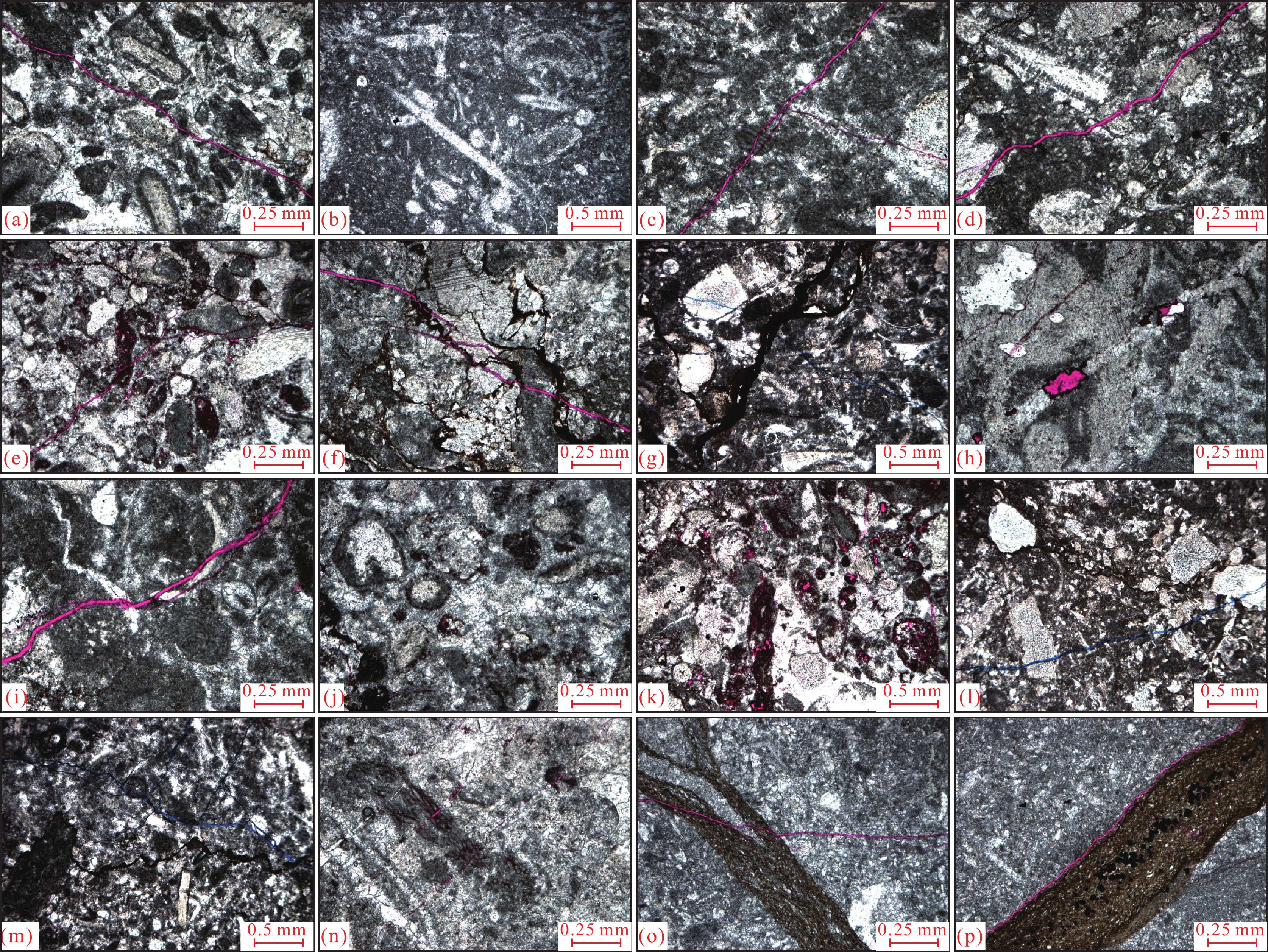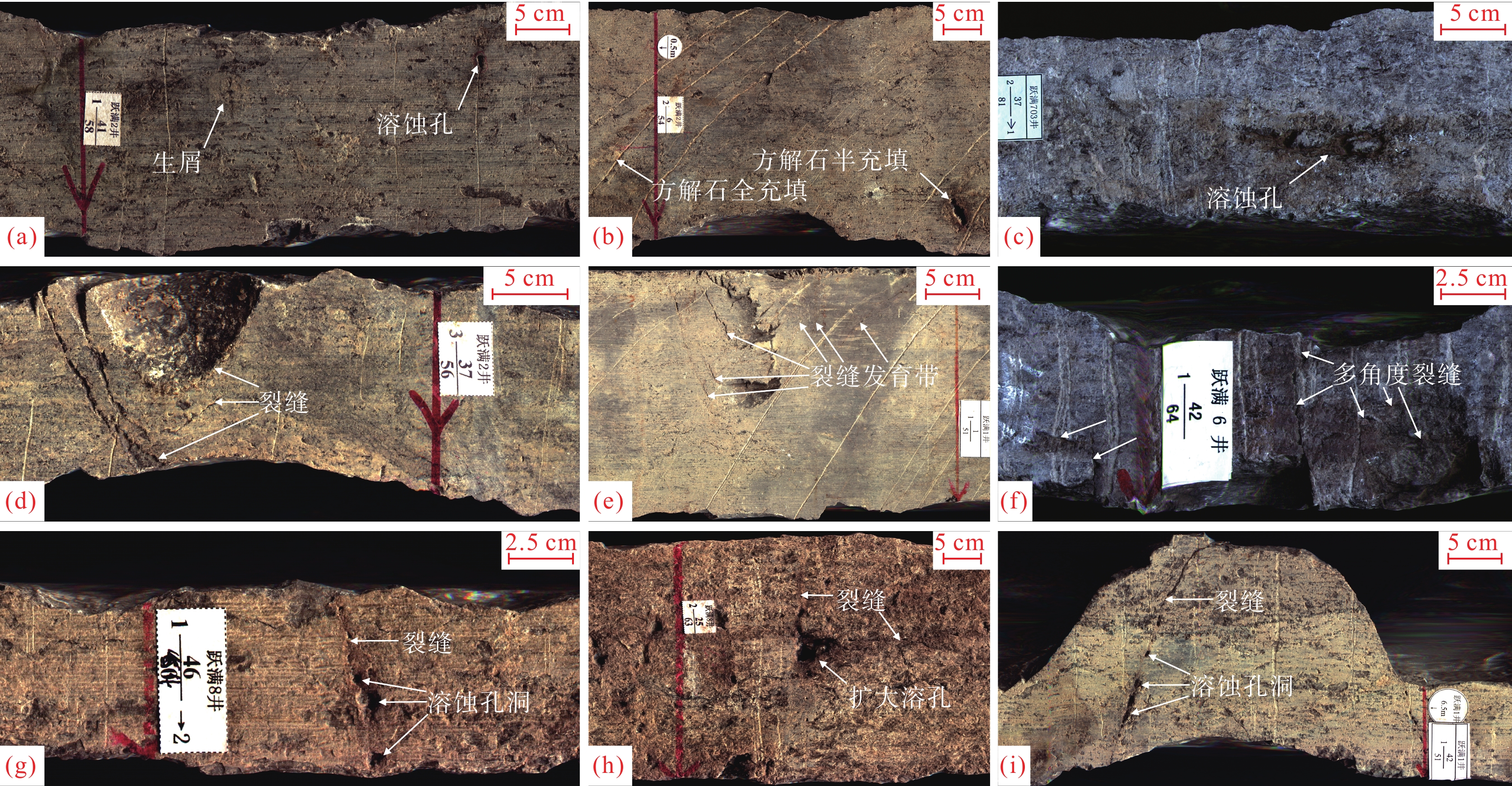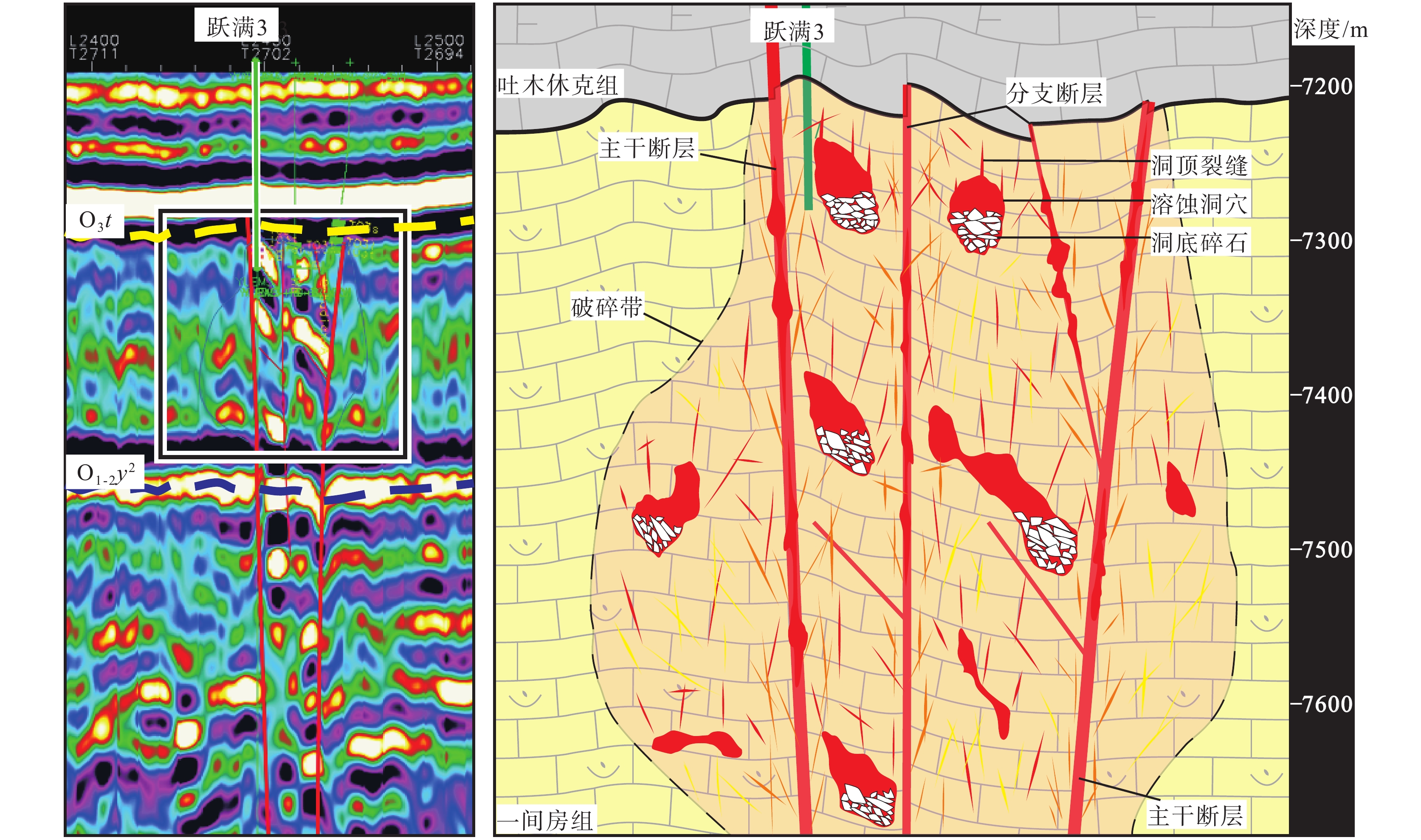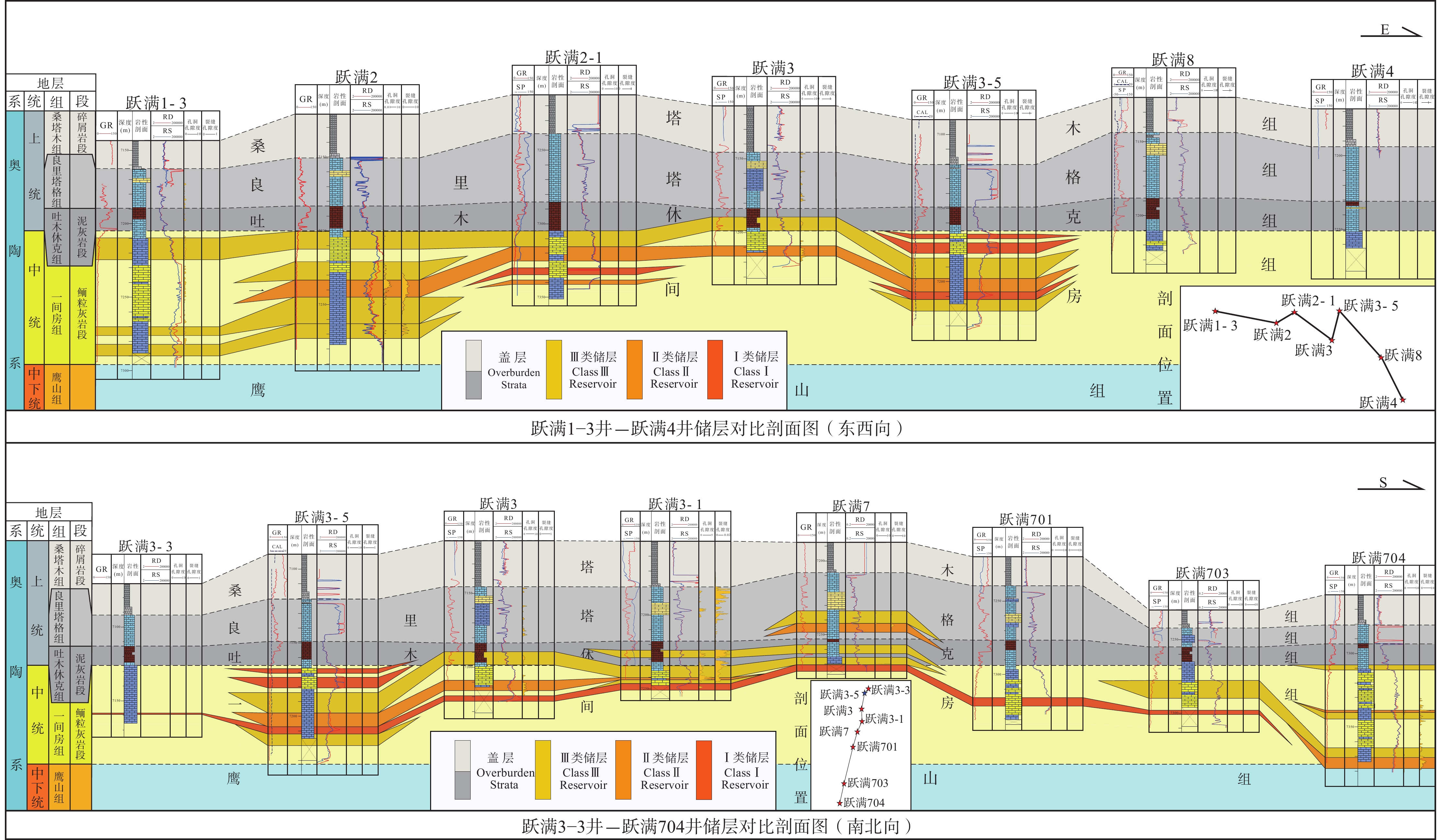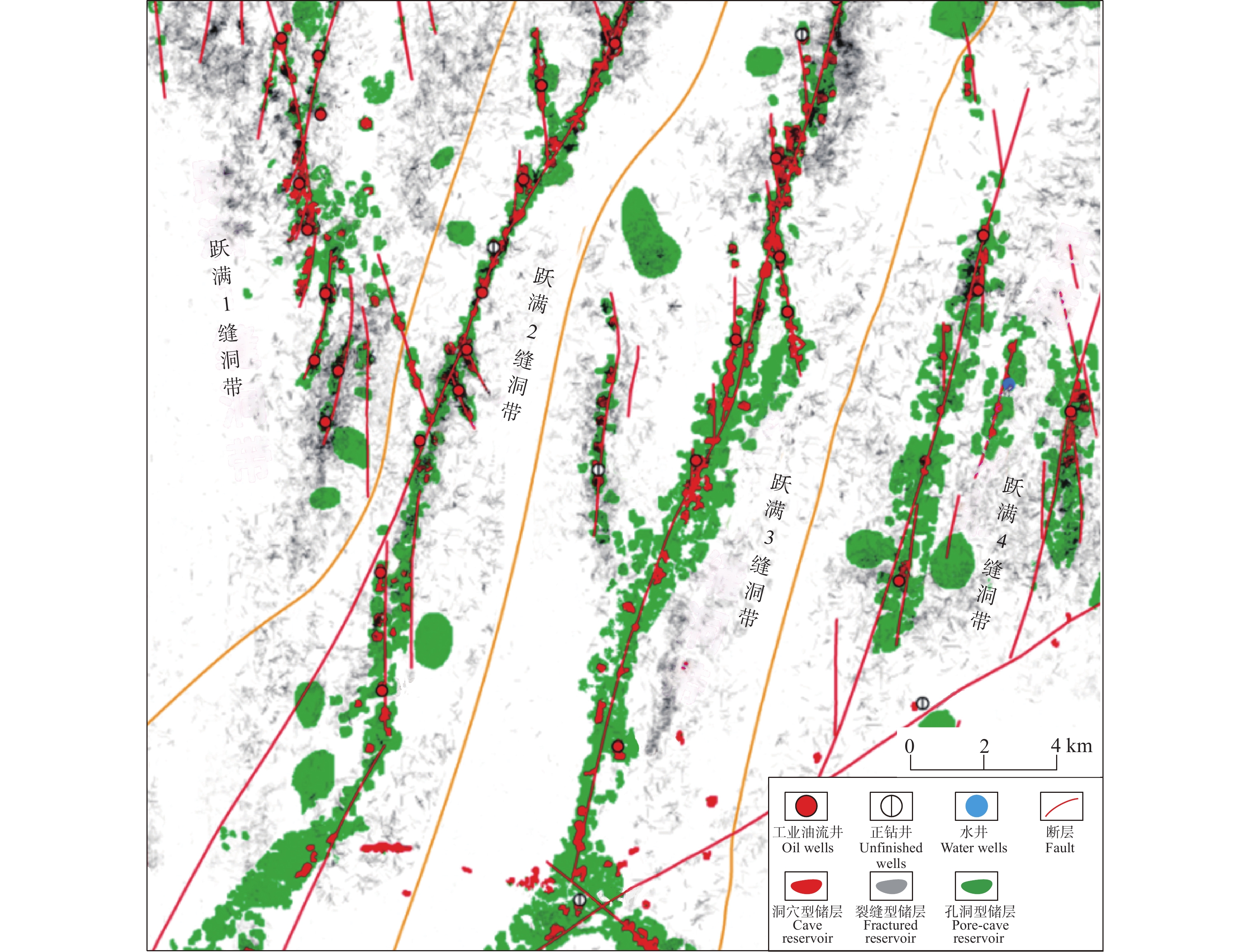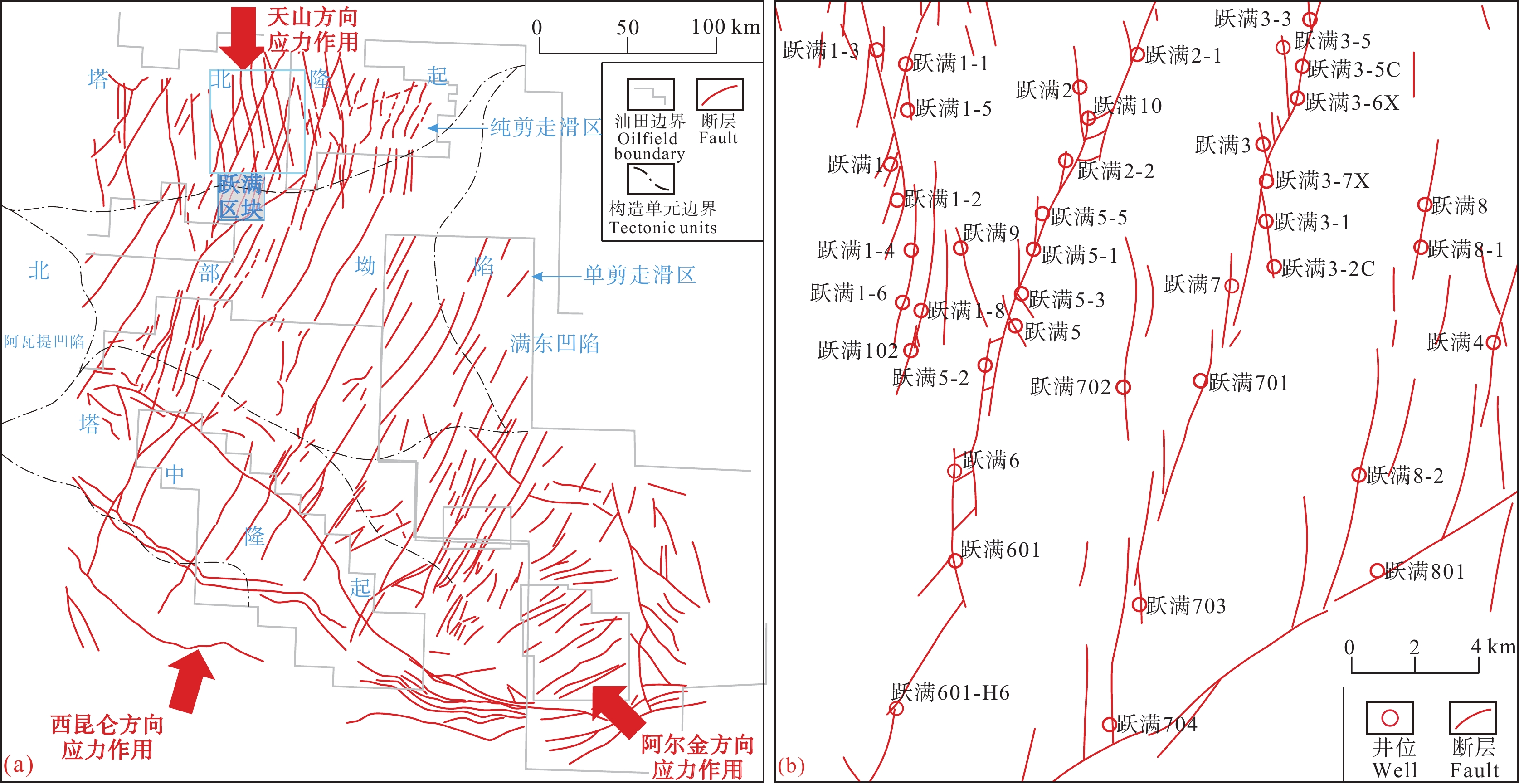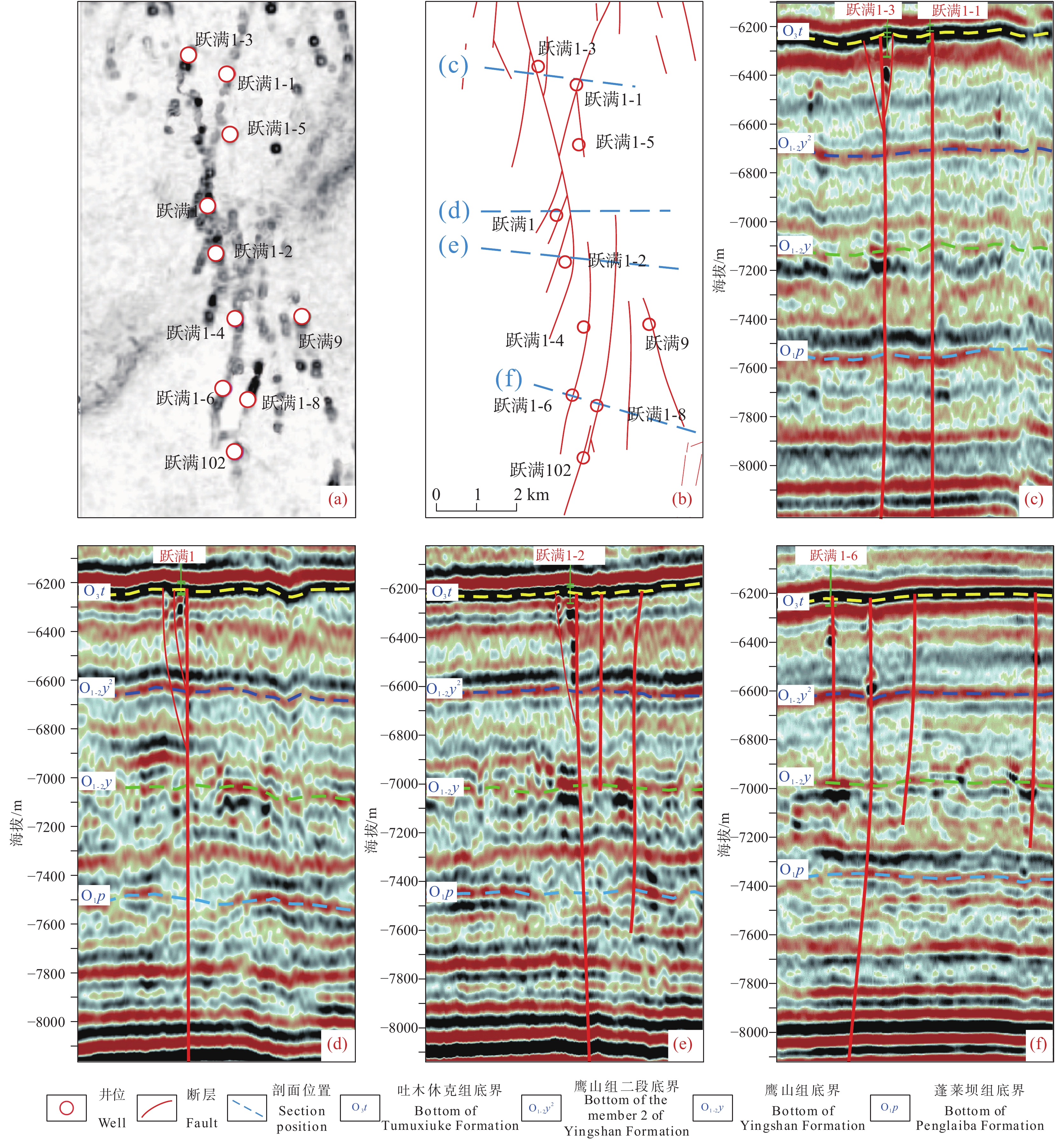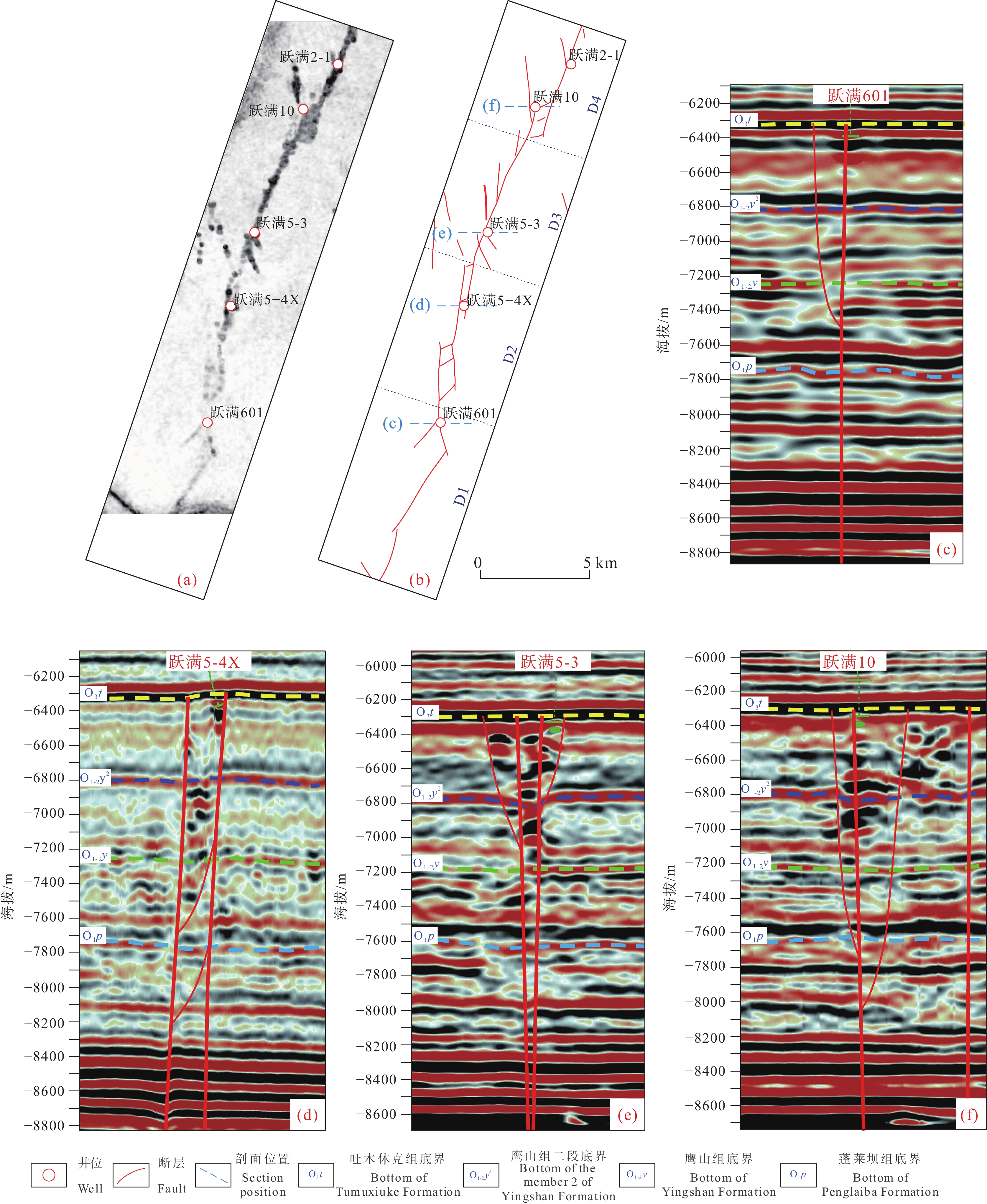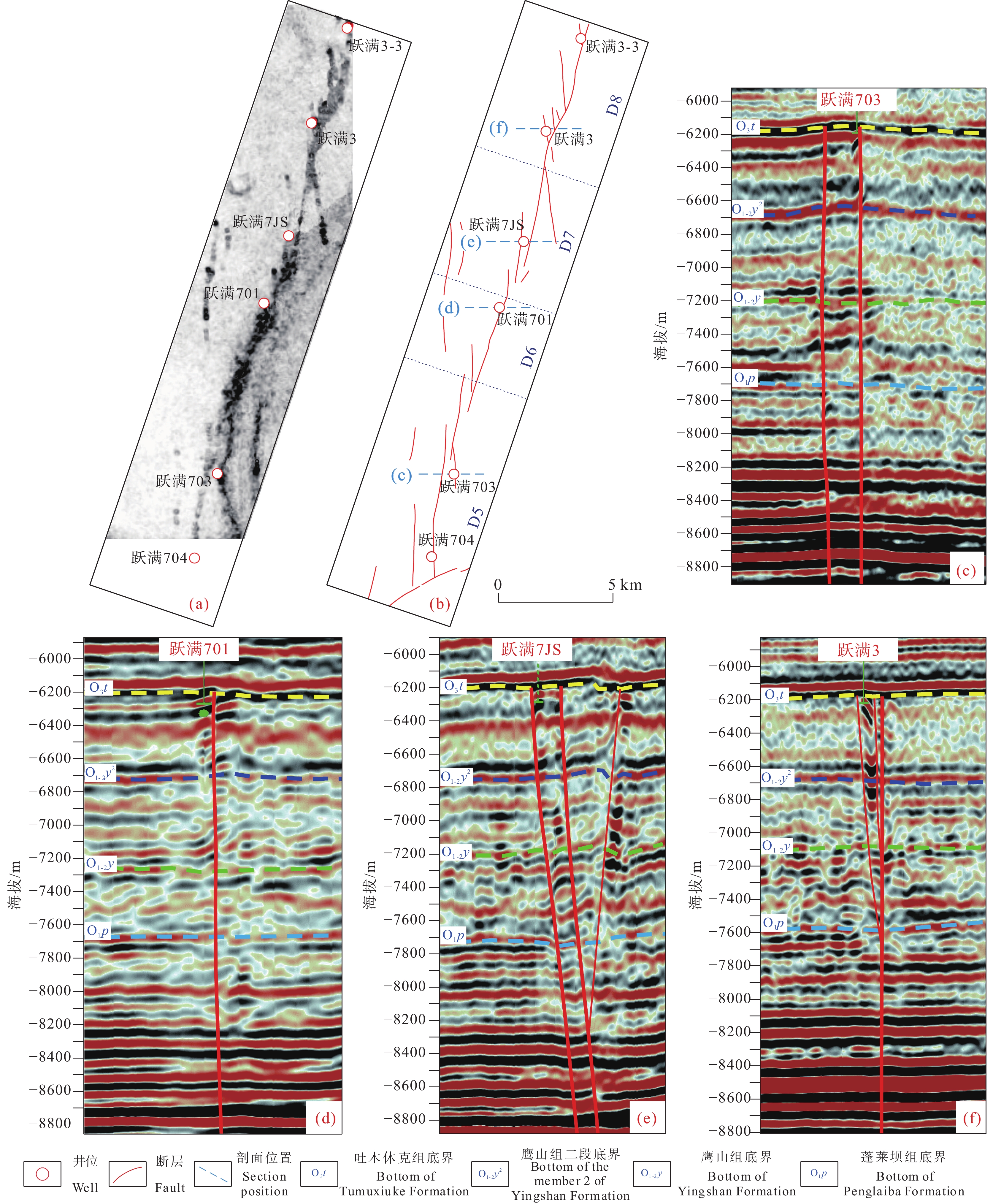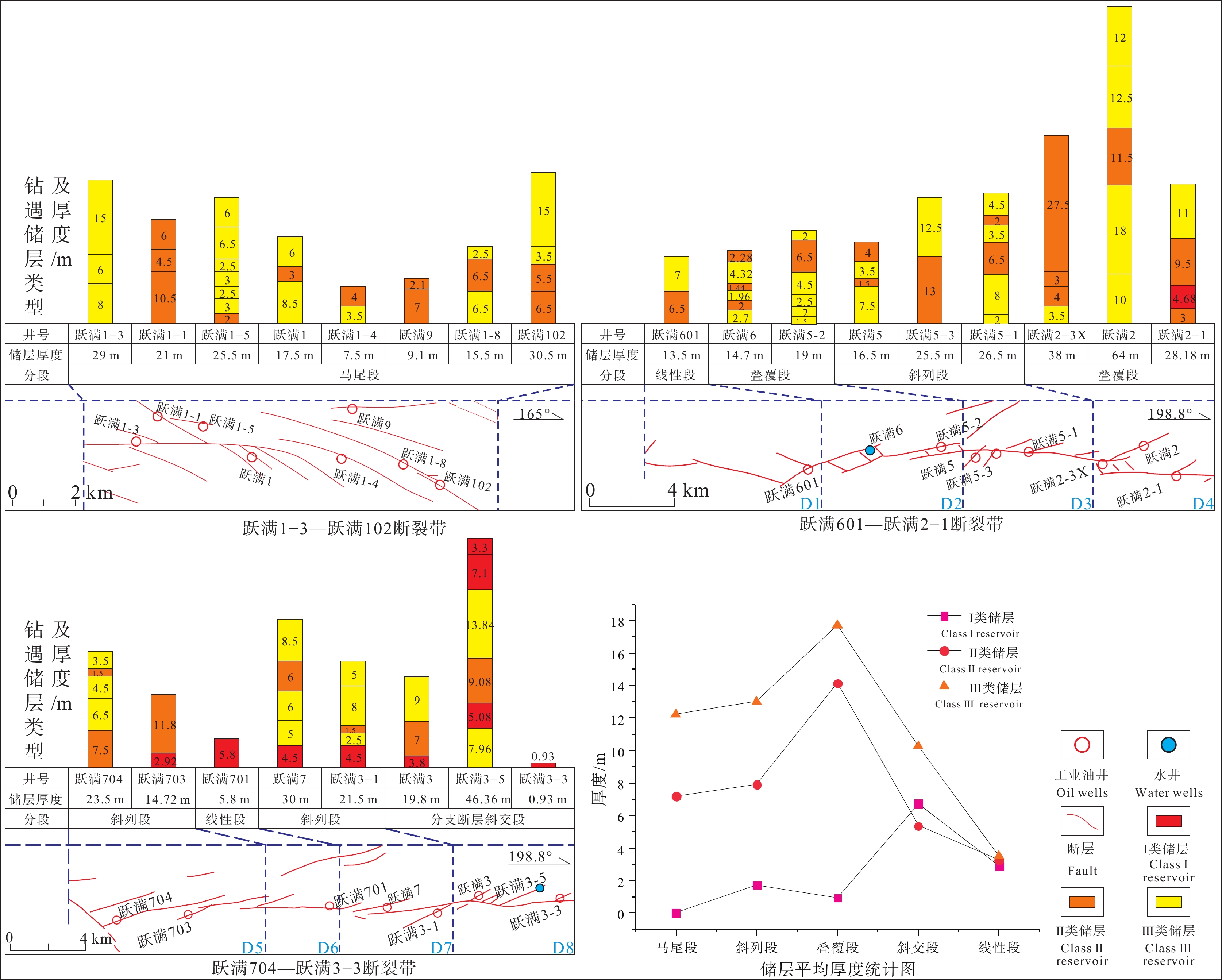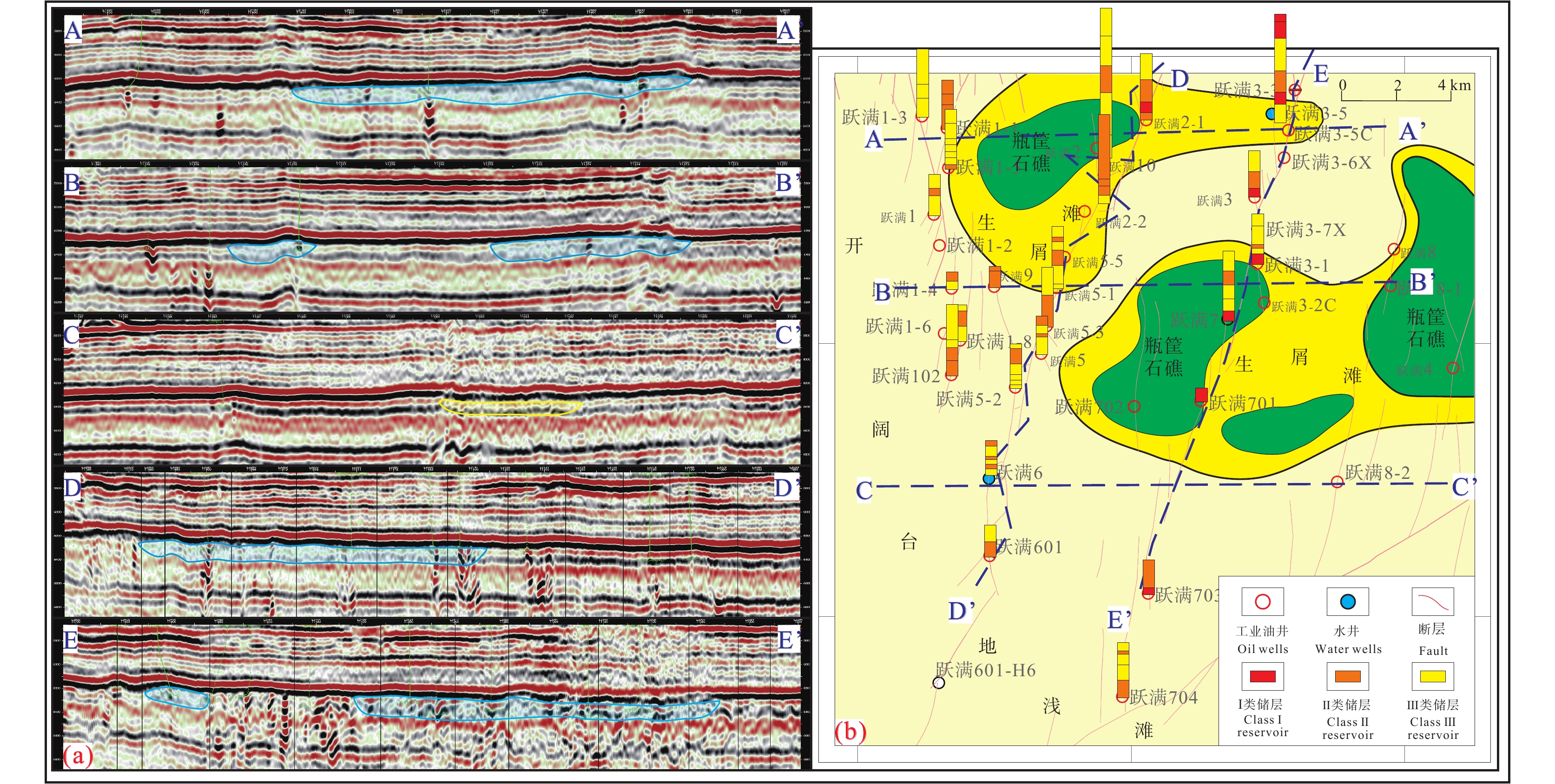Shale gas accumulation conditions and exploration prospects of Wufeng−Longmaxi Formation in Shixi Area, Northern Guizhou
-
摘要:研究目的
文章旨在通过分析狮溪地区狮溪1井五峰组—龙马溪组页岩成藏要素,揭示黔北地区复杂构造区页岩气成藏条件,查明黔北地区五峰组—龙马溪组页岩气成藏潜力。
研究方法本次研究基于黔北地区狮溪1井的系列钻井取心、测井曲线、地震资料、地化测试以及储层特征等综合实验分析,围绕“生—储—保”三个维度开展页岩气成藏综合研究。
研究结果狮溪1井五峰组—龙马溪组富有机质页岩厚度约25 m,TOC含量分布在2.79%~4.77%,等效镜质体反射率为2.01%~2.59%,有机质类型以I型为主,具有良好的生气基础;富有机质页岩层段脆性矿物含量较高,平均值约为61.05%,具有较高的脆性;发育大量微纳米级孔隙,主要为有机质孔、无机—有机质复合孔,孔体积以及比表面积参数表现良好,为页岩气的赋存提供了良好的储集空间;残留向斜内部富有机质页岩段顶底板具有较好的封闭能力,三者纵向上形成良好的生储盖组合;狮溪1井东部与西部发育两条通天断裂,距离断层较远的同时,得益于断层较好的封闭性以及平缓的地层产状,狮溪1井因而具有良好的含气显示。
结论黔北地区残留向斜内部五峰组—龙马溪组页岩同样具有页岩气高效、规模建产的油气地质条件,是下一步勘查与攻关研究的重点方向。该成果扩大了页岩气勘查范围,拓宽了四川盆地周缘页岩气勘探深度和广度,有望形成新的资源接替区。
创新点:本成果围绕页岩气成藏“生—储—保”三个要素,分析狮溪1井页岩气成藏条件,探索黔北地区页岩气勘探潜力,证实了复杂构造区同样具有良好的页岩气勘探前景。成果对四川盆地周缘页岩气有利区优选具有重要指导作用。
Abstract:This paper is the result of oil and gas exploration engineering.
ObjectiveThe purpose of this paper is to reveal the shale gas accumulation conditions in the complex structural area and to identify the shale gas accumulation potential of Wufeng Formation−Longmaxi Formation in Northern Guizhou by analyzing the shale accumulation elements of Wufeng−Longmaxi Formation in Well SX 1.
MethodsThis paper focuses on the comprehensive study of shale gas accumulation from the three dimensions of "source, reservoir, and protection", based on the comprehensive experimental analysis of the series drilling coring, logging curves, seismic data, and geochemical testing and reservoir characteristics of Well SX−1.
ResultsThe thickness of organic−rich shale in Wufeng−Longmaxi Formation of Well SX 1 is about 25 m, the TOC content is between 2.79% and 4.77%, and the equivalent vitrinite reflectance is about 2.01%−2.59%. The organic matter type is the primary type I, which has a good gas foundation. The content of brittle minerals in the organic−rich shale section is relatively high, with an average value of about 61.05%, indicating high brittleness. A large number of micro−nano pores are developed, mainly organic pores and inorganic−organic composite pores. The pore volume and specific surface area parameters are good, which provides a good reservoir space for the occurrence of shale gas. The roof and floor of the organic−rich shale section in the residual syncline have a good sealing ability. The three vertically form a good source−reservoir−cap assemblage. There are two large faults in the east and west of Well SX 1, but they are far from Well SX 1. At the same time, due to the good sealing of the faults and the gentle formation occurrence, Well SX 1 has a good gas−bearing display.
ConclusionsIn summary, the shale of Wufeng−Longmaxi Formation in the residual syncline in northern Guizhou also has oil and gas geological conditions with high efficiency and large−scale production of shale gas, which is the key direction of next exploration and research. The results expand the scope of shale gas exploration, broaden the depth and breadth of shale gas exploration around the Sichuan Basin, and are expected to form a new resource replacement area.
Highlights:Based on the three elements of "generation, storage and conservation" of shale gas accumulation, this achievement analyzes the shale gas accumulation conditions of Well SX 1, explores the shale gas exploration potential in northern Guizhou, and confirms that the complex structural area also has good shale gas exploration prospects. The results play an important guiding role in the selection of shale gas favorable areas around Sichuan Basin.
-
1. 引 言
塔里木盆地古生界碳酸盐岩储层分布广,厚度大,生储盖空间配置优越(翟光明等, 2004),围绕古隆起发育的塔北油田与塔中油田更是中国陆上碳酸盐岩油气勘探开发研究的重点区块(Yang et al., 2007; 何治亮等, 2016)。塔北油田的开发经历了自北部潜山区向南到顺层改造区的探索,形成了一套以浅层风化壳岩溶及层间岩溶为主控的缝洞体油藏的认识(沈安江等, 2019)。随着勘探开发逐步深入到台缘叠加区,已有油藏体系认知无法对低隆区油藏的开发进行有效指导,开发陷入瓶颈。随着顺北1号与顺北5号深层—超深层奥陶系碳酸盐岩储层取得重大突破(Jiao et al., 2018),受断裂控制的断溶体油气藏逐渐成为油田勘探开发的重点,对油气藏的认识也逐步转变为深大断裂控储、控藏、控富研究(王新新等, 2019; 丁志文等, 2020)。
塔里木盆地地质历史上构造运动强烈,经历多期构造运动,受区域应力场作用,稳定克拉通内部发育一系列陆内短滑距走滑断裂(Han et al., 2017; 邓尚等, 2021),最新三维地震勘探揭示,多期构造作用形成的走滑断裂继承性发育,形成多种构造样式,导致油气分布具有明显的区段性(邬光辉等, 2011)。同时,受断裂控制的断溶体油气藏特征表现出仅沿断裂带含油、且不均匀富集的特点(Wu et al., 2018; Jiao et al., 2018),表明走滑断裂是控制储层的重要因素(Wang et al., 2021),故进一步认识断裂对岩溶性储层的控制作用对碳酸盐岩油气的勘探具有重要意义。
2. 区域地质概况
跃满区块构造上位于塔里木盆地塔北隆起轮南低凸起的西部斜坡带(图1),轮南低凸起为一大型潜山背斜,面积15100 km2,主体在轮南油田至塔河油田一带,长轴在东部为北东向,西部为北东东向。跃满区块为向西倾没的哈拉哈塘大型鼻状构造一部分,北接轮台凸起,南衔北部坳陷,西邻英买力低凸起。研究区区域构造演化主要经历了中、晚加里东运动差异抬升期,晚海西—印支运动挤压抬升期,燕山—早喜山运动局部调整期,晚喜山运动至今构造反转期(马德波等, 2020)。
跃满区块地层发育完整,自上而下钻遇新生界第四系,新近系和古近系,中生界白垩系、侏罗系、三叠系,古生界二叠系、石炭系、志留系以及奥陶系。奥陶系可细分为上奥陶统桑塔木组(O3s)、良里塔格组(O3l)、吐木休克组(O3t);中奥陶统一间房组(O2y);中—下奥陶统鹰山组(O1-2y);下奥陶统蓬莱坝组(O1p)(朱光有等, 2011)。勘探开发目的层主要为奥陶系一间房组海相碳酸盐岩地层,上覆吐木休克组为一致密泥灰岩层,可以形成良好的油气封闭条件,有利于下伏一间房组油气成藏。
3. 储层特征
3.1 储层岩石学特征
岩心、薄片和测井资料表明,跃满地区中奥陶统一间房组储集岩以灰岩为主,岩性主要为生屑灰岩、砂屑灰岩、颗粒灰岩、泥晶灰岩(图2),为开阔台地相的台内砂屑、藻屑滩沉积岩类。岩心孔渗分析结果显示孔隙度平均值1.00%、渗透率平均值1.160×10−3 μm2,均为较低水平,且孔隙度与渗透率相关性不明显。
![]() 图 2 跃满地区奥陶系一间房组储层岩性(染色铸体薄片)a—跃满2井,井深:7211.8 m,亮晶生屑灰岩,构造缝;b—跃满2井,井深:7200.6 m,泥晶生屑灰岩;c—跃满2井,井深:7209.7 m,泥亮晶生屑灰岩,构造缝;d—跃满2井,井深:7206.7 m,泥粉晶生屑灰岩,构造缝;e—跃满2井,井深:7215.7 m,亮晶藻团块生屑灰岩,构造缝;f—跃满2井,井深:7209.9 m,泥亮晶生屑灰岩,构造缝与压溶缝;g—跃满2井,井深:7201.7 m,泥晶生屑灰岩,构造缝,压溶缝;h—跃满2井,井深:7210.7 m,方解石和沥青质半充填的构造缝;i—跃满2井,井深:7207.3 m,亮晶藻砂屑灰岩,构造缝,方解石全充填的溶蚀缝;j—跃满2井,井深:7216.7 m,亮晶生屑藻砂屑灰岩,粒内溶孔;k—跃满2井,井深:7217.6 m,泥亮晶生屑藻砂屑灰岩,粒内溶孔;l—跃满2井,井深:7212.6 m,亮晶颗粒灰岩,构造缝,压溶缝;m—跃满2井,井深:7213.7 m,亮晶颗粒灰岩,构造缝,压溶缝;n—跃满2井,井深:7214.5 m,粉晶颗粒灰岩,方解石半充填构造缝;o—跃满2井,井深:7196.5 m,生屑泥晶灰岩,构造缝;p—跃满2井,井深:7197.5 m,生屑泥晶灰岩,收缩缝Figure 2. Reservoir lithology of Ordovician Yijianfang Formation in Yueman area (dyed cast thin section)a−Well Yueman 2, depth: 7211.8 m, sparry bioclastic limestone, structural fracture; b−Well Yueman 2, depth: 7200.6 m, micrite bioclast limestone; c−Well Yueman 2, depth: 7209.7 m, micrite−sparry bioclast limestone, structural fracture; d−Well Yueman 2, depth: 7206.7 m, micrite−powder bioclast limestone, structural fracture; e−Well Yueman 2, depth: 7215.7 m, sparry clumpy alga bioclastic limestone, structural fracture; f−Well Yueman 2, depth: 7209.9 m, micrite−sparry bioclast limestone, structural fracture, pressolutional fracture; g−Well Yueman 2, depth: 7201.7 m, micrite bioclast limestone, structural fracture, pressolutional fracture; h−Well Yueman 2, depth: 7210.7 m, structural fracture, half−filled with calcite and asphalt; i−Well Yueman 2, depth: 7207.3 m, sparry algal arenaceous limestone, structural fracture, dissolution fracture, full−filled with calcite; j−Well Yueman 2, depth: 7216.7 m, Sparry bioclastic arenaceous limestone, intragranular dissolved pore; k−Well Yueman 2, depth: 7217.6 m, argillaceous sparry bioclastic arenaceous limestone, intragranular dissolved pore; l−Well Yueman 2, depth: 7212.6 m, sparry granular limestone, structural fracture, pressolutional fracture; m−Well Yueman 2, depth: 7213.7 m, sparry granular limestone, structural fracture, pressolutional fracture; n−Well Yueman 2, depth: 7214.5 m, silt−grained limestone, half−filled with calcite, structural fracture ; o−Well Yueman 2, depth: 7196.5 m, bioclastic micritic limestone, structural fracture; p−Well Yueman 2, depth: 7197.5 m, bioclastic micritic limestone, shrinkage fracture
图 2 跃满地区奥陶系一间房组储层岩性(染色铸体薄片)a—跃满2井,井深:7211.8 m,亮晶生屑灰岩,构造缝;b—跃满2井,井深:7200.6 m,泥晶生屑灰岩;c—跃满2井,井深:7209.7 m,泥亮晶生屑灰岩,构造缝;d—跃满2井,井深:7206.7 m,泥粉晶生屑灰岩,构造缝;e—跃满2井,井深:7215.7 m,亮晶藻团块生屑灰岩,构造缝;f—跃满2井,井深:7209.9 m,泥亮晶生屑灰岩,构造缝与压溶缝;g—跃满2井,井深:7201.7 m,泥晶生屑灰岩,构造缝,压溶缝;h—跃满2井,井深:7210.7 m,方解石和沥青质半充填的构造缝;i—跃满2井,井深:7207.3 m,亮晶藻砂屑灰岩,构造缝,方解石全充填的溶蚀缝;j—跃满2井,井深:7216.7 m,亮晶生屑藻砂屑灰岩,粒内溶孔;k—跃满2井,井深:7217.6 m,泥亮晶生屑藻砂屑灰岩,粒内溶孔;l—跃满2井,井深:7212.6 m,亮晶颗粒灰岩,构造缝,压溶缝;m—跃满2井,井深:7213.7 m,亮晶颗粒灰岩,构造缝,压溶缝;n—跃满2井,井深:7214.5 m,粉晶颗粒灰岩,方解石半充填构造缝;o—跃满2井,井深:7196.5 m,生屑泥晶灰岩,构造缝;p—跃满2井,井深:7197.5 m,生屑泥晶灰岩,收缩缝Figure 2. Reservoir lithology of Ordovician Yijianfang Formation in Yueman area (dyed cast thin section)a−Well Yueman 2, depth: 7211.8 m, sparry bioclastic limestone, structural fracture; b−Well Yueman 2, depth: 7200.6 m, micrite bioclast limestone; c−Well Yueman 2, depth: 7209.7 m, micrite−sparry bioclast limestone, structural fracture; d−Well Yueman 2, depth: 7206.7 m, micrite−powder bioclast limestone, structural fracture; e−Well Yueman 2, depth: 7215.7 m, sparry clumpy alga bioclastic limestone, structural fracture; f−Well Yueman 2, depth: 7209.9 m, micrite−sparry bioclast limestone, structural fracture, pressolutional fracture; g−Well Yueman 2, depth: 7201.7 m, micrite bioclast limestone, structural fracture, pressolutional fracture; h−Well Yueman 2, depth: 7210.7 m, structural fracture, half−filled with calcite and asphalt; i−Well Yueman 2, depth: 7207.3 m, sparry algal arenaceous limestone, structural fracture, dissolution fracture, full−filled with calcite; j−Well Yueman 2, depth: 7216.7 m, Sparry bioclastic arenaceous limestone, intragranular dissolved pore; k−Well Yueman 2, depth: 7217.6 m, argillaceous sparry bioclastic arenaceous limestone, intragranular dissolved pore; l−Well Yueman 2, depth: 7212.6 m, sparry granular limestone, structural fracture, pressolutional fracture; m−Well Yueman 2, depth: 7213.7 m, sparry granular limestone, structural fracture, pressolutional fracture; n−Well Yueman 2, depth: 7214.5 m, silt−grained limestone, half−filled with calcite, structural fracture ; o−Well Yueman 2, depth: 7196.5 m, bioclastic micritic limestone, structural fracture; p−Well Yueman 2, depth: 7197.5 m, bioclastic micritic limestone, shrinkage fracture3.2 储层类型
薄片、岩心及钻测井资料揭示(图2,图3;表1),研究区奥陶系碳酸盐岩储集空间宏观上以大型溶蚀洞穴、溶蚀孔洞及构造裂缝为主,微观上以孔隙(粒间孔、粒内孔、晶间孔、晶间溶孔)与微裂缝(构造缝、压溶缝、溶蚀缝)为主。根据洞、孔、缝组合特征,储层类型可分为洞穴型储层、裂缝−孔洞型储层、裂缝型储层与孔洞型储层4类,其中洞穴型储层储集能力最强,裂缝孔洞型储层兼具良好的储集与运移能力,分别为区内重点开发的Ⅰ类、Ⅱ类储层发育段,而裂缝型与孔洞型储层储集能力一般但分布广,多为Ⅲ类储层发育段。
![]() 图 3 跃满地区奥陶系一间房组储层类型(岩心)a—跃满2井,1−58−35,生屑砂屑灰岩,溶蚀孔洞;b—跃满2井,2−54−6,生屑砂屑灰岩,溶蚀孔洞,方解石全充填、半充填;c—跃满703井,2−81−37,生屑灰岩,溶蚀孔洞;d—跃满2井,3−56−37,砂屑生屑灰岩,中高角度缝;e—跃满1井,1−51−1,砂屑灰岩,中高角度缝,沿缝发育溶蚀孔;f—跃满6井,1−64−42,砂屑灰岩,直立缝与水平缝近垂直共轭;g—跃满8井,1−64−46,砂屑灰岩,高角度裂缝,沿裂缝溶蚀孔洞发育,见油斑;h—跃满8井,2−63−25,砂屑灰岩,直立缝与水平缝交汇处溶孔扩大;i—跃满1井,1−51−42,砂屑灰岩,中高角度裂缝,沿裂缝溶蚀孔洞发育Figure 3. Reservoir type of the Yijianfang Formation of Ordovician in Yueman area (cores)a−Well Yueman 2, 1−58−35, bioclastic calcarenite, dissolved pore; b−Well Yueman 2, 2−54−6, bioclastic calcarenite, dissolved pore, full filled or half filled with calcite; c−Well Yueman 703, 2−81−37, bioclastic limestone, dissolved pore; d−Well Yueman 2, 3−56−37, sandy bioclastic limestone, middle−high angle fracture; e−Well Yueman 1, 1−51−1, calcarenite, middle−high angle fracture, dissolved pore; f−Well Yueman 6, 1−64−42, calcarenite, horizontal and vertical fractures; g−Well Yueman 8, 1−64−46, calcarenite, high Angle fracture, dissolved pore, oil patch; h−Well Yueman 8, 2−63−25, calcarenite, horizontal and vertical fractures, dissolved pore increase at fracture intersections; i−Well Yueman 1, 1−51−42, calcarenite, middle−high angle fracture, dissolved pore表 1 跃满区块漏失统计Table 1. Lost circulation statistics in Yueman area
图 3 跃满地区奥陶系一间房组储层类型(岩心)a—跃满2井,1−58−35,生屑砂屑灰岩,溶蚀孔洞;b—跃满2井,2−54−6,生屑砂屑灰岩,溶蚀孔洞,方解石全充填、半充填;c—跃满703井,2−81−37,生屑灰岩,溶蚀孔洞;d—跃满2井,3−56−37,砂屑生屑灰岩,中高角度缝;e—跃满1井,1−51−1,砂屑灰岩,中高角度缝,沿缝发育溶蚀孔;f—跃满6井,1−64−42,砂屑灰岩,直立缝与水平缝近垂直共轭;g—跃满8井,1−64−46,砂屑灰岩,高角度裂缝,沿裂缝溶蚀孔洞发育,见油斑;h—跃满8井,2−63−25,砂屑灰岩,直立缝与水平缝交汇处溶孔扩大;i—跃满1井,1−51−42,砂屑灰岩,中高角度裂缝,沿裂缝溶蚀孔洞发育Figure 3. Reservoir type of the Yijianfang Formation of Ordovician in Yueman area (cores)a−Well Yueman 2, 1−58−35, bioclastic calcarenite, dissolved pore; b−Well Yueman 2, 2−54−6, bioclastic calcarenite, dissolved pore, full filled or half filled with calcite; c−Well Yueman 703, 2−81−37, bioclastic limestone, dissolved pore; d−Well Yueman 2, 3−56−37, sandy bioclastic limestone, middle−high angle fracture; e−Well Yueman 1, 1−51−1, calcarenite, middle−high angle fracture, dissolved pore; f−Well Yueman 6, 1−64−42, calcarenite, horizontal and vertical fractures; g−Well Yueman 8, 1−64−46, calcarenite, high Angle fracture, dissolved pore, oil patch; h−Well Yueman 8, 2−63−25, calcarenite, horizontal and vertical fractures, dissolved pore increase at fracture intersections; i−Well Yueman 1, 1−51−42, calcarenite, middle−high angle fracture, dissolved pore表 1 跃满区块漏失统计Table 1. Lost circulation statistics in Yueman area序号 井号 放空长/m 漏失量/m3 序号 井号 放空长/m 漏失量/m3 1 跃满1 1.92 355 18 跃满5−4X 6.39 659 2 跃满10 0 506.12 19 跃满5−5 1.85 148.4 3 跃满1−1 0 535.7 20 跃满601 0 373.7 4 跃满1−3 0.12 118.24 21 跃满6C 0 215.5 5 跃满1−5 0.76 0 22 跃满701 0 260.4 6 跃满2−2C 0 1200 23 跃满701−H1 1.11 1494.4 7 跃满2−4X 1.41 2049 24 跃满702 0 133.2 8 跃满3 0 253.4 25 跃满703 2.72 252.2 9 跃满3−1 1.49 307.1 26 跃满7−1X 0 1558.11 10 跃满3−2C 0 1063.2 27 跃满7−2X 0.34 1527.19 11 跃满3−3 0.93 348.5 28 跃满7JS 19.1 3231.33 12 跃满3−5 0.74 114.6 29 跃满8 4.02 773.5 13 跃满3−5C 8 1064.6 30 跃满801 2.79 1389.18 14 跃满3−6X 0.96 241.6 31 跃满801−H6 2.59 549.4 15 跃满3−7X 0 9.9 32 跃满802 1.45 329.7 16 跃满4 0 43.8 33 跃满8−1 6.34 286.2 17 跃满5−3 0 269.4 34 跃满9 9.25 811 孔洞型、裂缝型、裂缝−孔洞型储层在区内大量发育。其中孔洞型储层以一间房组开阔台地相台内滩和台地边缘相台缘礁滩体等高能相带为发育基础,层状发育且具有较好的孔隙度与渗透率,储层段岩心薄片可见微观粒间溶孔、铸膜孔、粒内溶孔等(图2e、k),可见部分孔洞被方解石充填,岩心可见不规则溶蚀孔洞发育,部分被方解石半充填、全充填(图3a~c)。裂缝型储层区内普遍发育,连通溶蚀洞穴、孔洞或成组发育的裂缝型储层更为有效,薄片可见沥青与泥质全充填的压溶缝,方解石全充填、半充填的溶蚀缝,未充填的构造缝等(图2f、h、i);岩心显示裂缝以中高角度—高角度构造缝为主,形态总体较规则,缝面较平坦,具成组发育特征(图3d~f)。裂缝−孔洞型储层主要分布于一间房组开阔台地相台内滩颗粒灰岩中,兼具良好的运移与储集能力,岩心显示,沿裂缝溶蚀孔洞发育,且多裂缝交汇处溶蚀孔洞发育更佳(图3g~i)。
洞穴型储层以大型溶蚀洞穴为主要储集空间,洞穴围岩裂缝及洞底碎石孔隙为次要储集空间,新三维地震资料显示,洞穴在地震剖面上表现出强串珠状反射特征,该类储层主要发育于一间房组上部,沿主干断层或断层两侧垂向发育(图4)。
钻井资料上洞穴型储层表现为放空和漏失,跃满区块已有钻井的放空漏失现象统计显示,区内共完钻51口井,放空21井,占比41.2%,平均放空3.537 m,最长放空跃满7JS井,放空长达19.1 m,最短放空跃满1−3井,仅放空0.12 m;同时总计33井有漏失现象,占比64.7%,平均漏失681.0 m3,最小漏失跃满3−7X井共9.9 m3,最大漏失跃满7JS井共3231 m3(表1),放空漏失现象普遍。
3.3 储层发育规律
综合钻、测井及三维地震资料,对比东西向与南北向相邻井所揭示的岩性、储层及沉积特征,对区内储层分布特征进行厘定,结果表明,在垂向上,储层主要分布于一间房组顶面以下0~120 m范围之内,少量钻井(跃满3、跃满7)揭示上覆吐木休克组与良里塔格组有少量Ⅱ类和Ⅲ类储层发育;在横向剖面上,储层表现出强非均质性以及低连续性:各井储层类型、储层厚度差异较大,东西向连井对比图显示各井储层连续性差,而在近南北断层走向上,连井对比图显示储层具有一定连续性(图5);在一间房组,洞穴型储层沿断裂孤立发育,孔洞型储层与裂缝型储层沿断裂带状发育,同时,不同断裂构造段内储层发育具有显著差异性,特别是洞穴型储层,往往集中于局部断裂大量发育,显示出强烈的断控特征(图6)。
4. 走滑断裂特征
塔里木盆地经历多期不同方向的斜向构造挤压作用,盆内发育多组走滑断裂系统,按形成的力学机制可分为纯剪机制和单剪机制(图7)。研究区受古昆仑洋及阿尔金板块俯冲消解作用,形成多组纯剪机制的“X”型共轭走滑断裂带(Tang et al., 2012; 孙东等, 2015),在此基础上,共轭断层相继滑动、切割调节,形成的不连续断层经过尾端扩张与连接生长,最终形成位移量极少的“小位移”长断裂带。通过断裂带碳酸盐胶结物U−Pb测年结合地震解析,确定塔里木盆地奥陶系碳酸盐岩走滑断裂活动始于距今约460 Ma的中奥陶世末期(Wu et al., 2021)。跃满区块位于塔北哈拉哈塘地区南部,为共轭走滑断裂发育区的边缘地带,区内主要发育一组北北西向与三组北北东向走滑断裂(图7)。
![]() 图 7 塔北至塔中地区(a,据Wu et al., 2021修改)跃满区块(b)走滑断裂体系纲要图Figure 7. Schematic diagram of strike−slip faults in Tabei−Tazhong area (a, modified from Wu et al., 2021) and Yueman area (b)
图 7 塔北至塔中地区(a,据Wu et al., 2021修改)跃满区块(b)走滑断裂体系纲要图Figure 7. Schematic diagram of strike−slip faults in Tabei−Tazhong area (a, modified from Wu et al., 2021) and Yueman area (b)4.1 走滑断裂分段特征
北北西向跃满1−3—跃满102断裂带位于跃满区块西北部,为北部金跃地区向南延伸的一号断裂的末端,具有强烈的应力发散特点,研究区可见有另一北北东向走滑断裂(跃满1−1井所在断裂)终止于该马尾断层。北北东向跃满601—跃满2−1断裂带与跃满704—跃满3−3断裂带位于研究区中部,是研究区油气开发的重点,两条断裂均延伸较长,跃满601—跃满2−1断裂带向南延伸至顺北区块后终止,向北穿过金跃、热普等区块,延伸至哈6区块被共轭北北西向断裂截断;跃满704—跃满3−3断裂带向南终止于北东东向的顺北1号断裂带,向北延伸至金跃区块后被截断。跃满801—跃满8走滑断裂仅在研究区发育,延伸较短、连续性差且前期勘探开发尚不完善,故暂不做分析研究。
在对区内沿断裂走向的高度差异表征断层应力特征研究的基础上,对断裂构造进行分段性研究,结果显示:跃满1−3—跃满102断裂带为一典型马尾段,平面上由主干断层与若干同向弯曲的短分支断层组成,分支断层向南散开形成典型的马尾状构造,最南端转变为扇形排布的雁列断层,地震剖面上,北部可见平行的主干断层与小的花状构造,中部可见半花状构造,南部多为深大半花状构造(图8)。
跃满601—跃满2−1断裂带自南向北可划分四段:D1线性段、D2叠覆段、D3斜列段、D4叠覆段。D1线性段为压扭性质,平面上为单条断层线性延伸,剖面上为单条直立断层;D2与D4左行右阶叠覆段均为张扭性质,平面上表现为主干断层错位发育,在断层之间形成条形叠覆区域,叠覆区内受拉张应力作用,发育多条与两主干断层大角度斜交的分支断层,D2段一大一小两个叠覆区连续发育,D4段叠覆区规模居中,剖面上主要表现为两条直立断层伴随半花状构造;D3斜列段中部为压扭性质,靠近叠覆段的两端为张扭性质,平面上由多条断层平行排列组成,剖面上主要表现为两条直立断层(图9)。
跃满704—跃满3−3断裂带自南向北可划分为四段:D5斜列段、D6线性段、D7斜列段、D8斜交段。D5斜列段为压扭性质,D7斜列段为张扭性质,平面上均为多条断层平行排列,与断层整体走向呈低角度交错,剖面上为两条直立断层;D6线性段为D5斜列段至D7斜列段间的过渡段,为张扭性质,平面上为单条主干断层,剖面上为单条陡直断层;D8斜交式断层应力性质表现为压扭与张扭交错,平面上为若干R剪切分支断层与主干断层组成,分支断层主要发育于主干断层以西,剖面上显示为发育在奥陶系内的半花状构造(图10)。
4.2 各构造段储层分布特征
根据三维地震资料揭示的洞穴及缝洞雕刻结果,区内布置并完成了30余口井的钻探工作,并对27口井进行了试采,在钻测井资料对储层的解析基础上,结合走滑断裂的分段特征对断裂不同构造段内储层发育情况进行统计分析(表2,表3,表4),结果表明:马尾段内,储层厚度普遍较厚,储层类型以裂缝型与孔洞型储层为主,裂缝孔洞型储层少量发育,未见洞穴型储层,储层发育整体较好;叠覆段与斜列段内,储层厚度普遍较厚,且各类储层均有发育,储层发育最佳;分支断层斜交段储层发育极不均匀,整体认为储层发育一般;线性段储层发育则普遍较差。
表 2 跃满区块钻井储层统计(跃满1−3—跃满102)Table 2. Reservoir statistics of drilling in Yueman area (Yueman 1−3−Yueman 102)分段 井号 顶深/m 底深/m 层厚/m 类型 顶深/m 底深/m 层厚/m 类型 马尾段 跃满1−3 7209 7224 15 Ⅲ 7282 7290 8 Ⅲ 7270 7276 6 Ⅲ 跃满1−1 7217 7223 6 Ⅱ 7227.5 7238 10.5 Ⅱ 7223 7227.5 4.5 Ⅱ 跃满1−5 7226 7232 6 Ⅲ 7287 7289.5 2.5 Ⅲ 7255 7261.5 6.5 Ⅲ 7295.5 7298.5 3 Ⅲ 7275.5 7278 2.5 Ⅲ 7301.5 7303.5 2 Ⅱ 7282.5 7285.5 3 Ⅲ 跃满1 7259.5 7265.5 6 Ⅲ 7268.5 7277 8.5 III 7265.5 7268.5 3 II 跃满1−4 7297 7301 4 Ⅱ 7303.5 7307 3.5 Ⅲ 跃满9 7586.8 7588.9 2.1 Ⅱ 7591 7598 7 Ⅱ 跃满1−8 7302.5 7305 2.5 Ⅲ 7343.5 7350 6.5 Ⅲ 7311 7317.5 6.5 Ⅱ 跃满102 7282 7297 15 Ⅲ 7300.5 7306 5.5 Ⅱ 7297 7300.5 3.5 Ⅲ 7306 7312.5 6.5 Ⅱ 表 4 跃满区块钻井储层统计(跃满704—跃满3−3)Table 4. Reservoir statistics of drilling in Yueman area (Yueman 704−Yueman 3−3)分段 井号 顶深/m 底深/m 层厚/m 类型 顶深/m 底深/m 层厚/m 类型 斜列段 跃满704 7307.5 7311 3.5 Ⅲ 7364 7370.5 6.5 Ⅲ 7338.5 7340 1.5 Ⅱ 7370.5 7378 7.5 Ⅱ 7340 7344.5 4.5 Ⅲ 跃满703 7277.9 7289.7 11.8 Ⅲ 7298 7300.92 2.92 Ⅰ 线性段 跃满701 7315.7 7321.5 5.8 Ⅰ 斜列段 跃满7 7234 7242.5 8.5 Ⅲ 7265.5 7270.5 5 Ⅲ 7242.5 7248.5 6 II 7270.5 7275 4.5 Ⅰ 7257 7263 6 Ⅲ 跃满3−1 7224 7229 5 Ⅲ 7244 7246.5 2.5 Ⅲ 7234.5 7242.5 8 Ⅲ 7246.5 7251 4.5 Ⅰ 7242.5 7244 1.5 Ⅱ 分支断层
斜交段跃满3 7189.5 7198.5 9 Ⅲ 7219.4 7223.2 3.8 Ⅰ 7209 7216 7 Ⅱ 跃满3−5 7167.7 7171 3.3 Ⅰ 7197.88 7206.96 9.08 Ⅱ 7173.8 7180.9 7.1 Ⅰ 7206.96 7212.04 5.08 Ⅰ 7184.04 7197.88 13.84 Ⅲ 7212.04 7220 7.96 Ⅲ 跃满3−3 7158.62 7159.55 0.93 Ⅰ 表 3 跃满区块钻井储层统计(跃满601—跃满2−1)Table 3. Reservoir statistics of drilling in Yueman area (Yueman 601−Yueman 2−1)分段 井号 顶深/m 底深/m 层厚/m 类型 顶深/m 底深/m 层厚/m 类型 线性段 跃满601 7313 7320 7 Ⅲ 7372.5 7379 6.5 Ⅱ 叠覆段 跃满6 7294 7296.28 2.28 Ⅱ 7302.04 7304 1.96 Ⅲ 7296.28 7300.6 4.32 Ⅲ 7304 7306 2 Ⅱ 7300.6 7302.04 1.44 Ⅱ 7308 7310.7 2.7 Ⅲ 跃满5−2 7277 7279 2 Ⅲ 7301.5 7304 2.5 Ⅲ 7284 7290.5 6.5 Ⅱ 7313 7315 2 Ⅲ 7290.5 7295 4.5 Ⅲ 7318 7319.5 1.5 Ⅲ 斜列段 跃满5 7272.5 7276.5 4 Ⅱ 7280 7281.5 1.5 Ⅱ 7276.5 7280 3.5 Ⅲ 7281.5 7289 7.5 Ⅲ 跃满5−3 7258.5 7271 12.5 Ⅲ 7279 7292 13 Ⅱ 跃满5−1 7248.5 7253 4.5 Ⅲ 7263 7269.5 6.5 Ⅱ 7253 7255 2 Ⅱ 7269.5 7277.5 8 Ⅲ 7255 7258.5 3.5 Ⅲ 7280.5 7282.5 2 Ⅲ 叠覆段 跃满2−3X 7274 7301.5 27.5 Ⅱ 7319 7323 4 Ⅱ 7313 7316 3 Ⅱ 7323 7326.5 3.5 Ⅲ 跃满2 7200.5 7212.5 12 Ⅲ 7245 7263 18 III 7221 7233.5 12.5 Ⅲ 7263 7273 10 Ⅲ 7233.5 7245 11.5 Ⅱ 跃满2−1 7304.5 7315.5 11 Ⅲ 7329.76 7334.44 4.68 Ⅰ 7315.5 7325 9.5 Ⅱ 7338 7341 3 Ⅱ 5. 分析讨论
5.1 断控岩溶作用对储层发育的控制
综上所述,跃满区块走滑断裂分段特征与储层的发育规模具有一定的耦合关系,前人研究认为:塔北哈拉哈塘地区岩溶作用对碳酸盐岩储层具有直接控制作用(Dan et al., 2016; 梁乘鹏等, 2019),岩溶体系又主要受控于低水位期海平面下降、先存断裂及裂缝、地表河流体系(Liang and Jones, 2014; 宁超众等, 2020)。塔北奥陶系碳酸盐岩储层发育可分为四个阶段:一间房组准同生阶段、良里塔格组台缘滩沉积阶段、志留系前潜山岩溶阶段与后期埋藏溶蚀阶段(张学丰等, 2012; 赵学钦等, 2015),而非暴露区跃满区块位于塔北隆起最南缘,隆升幅度最小(廖涛等, 2016),故该区奥陶系储层主要受早期准同生岩溶与后三期埋藏岩溶作用,埋藏岩溶作用主要表现为深部溶蚀性流体沿断裂向上运移,改造一间房组碳酸盐岩,形成有效储集体(郑剑等, 2015; 牛君等, 2017)。分析认为断裂主要通过控制岩溶作用间接控制储层的发育,结合钻井与走滑断裂相对位置关系发现:区内储层发育程度受控于走滑断裂的构造样式及应力特征,构造样式越复杂,应力作用越集中,则岩溶作用更强,相应储层发育更好(图11)。
马尾段是断裂端部应力发散的结果,多条拉张性质的雁列断层与分支断层成组发育,整体构造样式较复杂,中部短马尾分支断层间距小、下切浅,南部长雁列断层间距大、下切深。断层间距越小,单位面积溶蚀作用则越强,而下切越深越有利于溶蚀性流体的上侵,马尾段储层统计显示,整体储层发育较好,平均厚度19.45 m,储层类型多为裂缝型、孔洞型以及裂缝−孔洞型,未见洞穴型储层发育。
斜列段与叠覆段均为应力集中区,且区内构造样式复杂,斜列的主干断层以及连通主干断层的分支断层均可作为流体的运移通道,溶蚀区域面积增大且溶蚀作用强度大幅增强,以主干断层夹持区溶蚀效果最好。区内钻井揭示,区内斜列段与叠覆段储层发育最佳,储层厚度均较厚,各井平均厚度23.46 m,最厚储层38 m(跃满2−3X井),最薄储层14.7 m(跃满6井),储层类型以裂缝孔洞型为主,各井均有多类储层发育。
分支断层斜交段局部应力集中,密集程度不一,多条分支断层逆向发育于断层西侧,分支断层长度不一,与马尾段类似,长分支断层具有更长的流体运移通道,分支断层密集区单位面积溶蚀作用更强,储层统计显示长分支断层储层厚度异常厚,例如跃满3−5井,储层厚46.36 m,各类储层均发育,短分支断层上储层发育一般,且非密集分支断层上的跃满3−3井储层发育极差,整体认为储层发育一般。
线性段均无构造应力集中,且构造样式简单,断层仅作为流体的运移通道,岩溶作用对该段内碳酸盐岩改造作用较弱。线性段内储层发育较差,厚度较薄且储层类型单一。
5.2 断控高能相带对储层发育的控制
研究区一间房组整体为开阔台地相,加里东中期—晚奥陶纪早期(加里东中期Ⅰ幕),塔北发生了一次较大规模的海退,一间房组短暂暴露,准同生岩溶大面积发育(倪新锋等, 2009),中奥陶世末期,走滑断裂开始活动并控制着区内微地貌(Wu et al., 2021),断裂挤压段易形成正地貌,有利于高能礁滩体发育,该类礁滩体受准同生期岩溶作用及自身结构影响,具有更好的孔隙度、渗透率(Zeng et al., 2018; 高达等, 2022),也更易受埋藏岩溶作用溶蚀改造,从而形成有效储集体。
新三维地震资料上不同沉积相带具有不同的地震响应特征:开阔台地相地震反射时差横向变化稳定,成平行、亚平行结构,振幅较强、连续,能量稳定;台内滩地震反射时差增大,反射杂乱,具有下超、上隆的特征,振幅变弱(聂杞连等, 2015)。连井地震剖面显示,区内一间房组顶部发育不规则的高能相带(图12),主要覆盖了跃满601—跃满2−1断裂带北部D3斜列段与D4叠覆段,跃满704—跃满3−3断裂带中北部D6线性段与D7斜列段。对比高能相带叠合区与非叠合区发现,在断裂分段性控制储层发育的基础上,高能相带的叠加区储层发育更好,与高能相带叠加的D4叠覆段相较D2叠覆段储层厚度更厚,叠加高能相带的D3斜列段和D7斜列段储层厚度相近,且储层厚度均高于D5斜列段。
6. 结 论
(1)跃满区块奥陶系一间房组储层发育,储集岩以生屑灰岩、砂屑灰岩、颗粒灰岩、泥晶灰岩为主。根据储集空间组合特征储层可分为洞穴型储层、裂缝−孔洞型储层、裂缝型储层和孔洞型储层四类。各类储层集中发育于一间房组顶部,沿走滑断裂带状分布。
(2)跃满区块位于塔北南坡纯剪走滑区,发育一组北北西向与三组北北东向走滑断裂。区内断裂具有分段性,按平面构造样式可分为马尾段、斜列段、叠覆段、分支断层斜交段和线性段。断裂不同段内平面组合特征、剖面构造特征和应力特征均有区别,马尾段应力发散,构造样式复杂,斜列段与叠覆段应力集中、构造样式复杂,分支断层斜交段局部应力集中、构造样式单一,线性段无构造应力集中,构造样式最简单。
(3)走滑断裂分段性影响埋藏岩溶作用强度及规模,从而控制储层发育程度与分布情况。研究区内马尾段、斜列段和叠覆段储层发育最佳,分支断层斜交段储层发育受控于分支断层长度,整体发育一般,线性段储层发育较差。此外,在断裂分段性控制储层发育的基础上,高能相带叠加区储层更为发育。
致谢: 项目研究过程中,中国石油塔里木油田勘探开发研究院的张银涛高级工程师、康鹏飞工程师,以及西南石油大学地球科学与技术学院的赵星星、崔晓庆、宋玉婷等在前期资料收集、数据处理上提供了指导和帮助,审稿专家与编辑对稿件提出了宝贵的修改意见。在此一并致以诚挚谢意!
-
图 5 狮溪1井五峰组—龙马溪组不同岩相页岩扫描电镜照片
a—1297.2 m,黏土质页岩,黏土矿物在压实作用下发生形变,发育黏土矿物收缩缝、溶蚀孔与黏土矿物—有机质复合孔;b—1297.2 m,黏土质页岩,发育黏土矿物收缩缝与溶蚀孔;c,d—1305.57 m,混合质页岩,脆性矿物间发育粒间孔,见溶蚀孔与黏土矿物收缩缝;e—1344.97 m,硅质页岩,黏土矿物因压实作用发生破裂而形成为裂缝,见黏土矿物收缩缝,有机质包裹微晶石英,内部发育大量有机质孔;f—1344.97 m,硅质页岩,黄铁矿包裹有机质形成黄铁矿—有机质复合孔,孔隙多呈不规则狭缝状与圆形、椭圆形
Figure 5. Scanning electron microscope photographs of different lithofacies shale of Wufeng−Longmaxi Formation, Well SX 1
a−1297.2 m, clay−rich siliceous shale, deformation of clay minerals under compaction, development of clay mineral shrinkage fracture, dissolution pore and clay mineral−organic composite pore; b−1297.2 m, clay−rich siliceous shale, shrinkage seam and dissolution pore of clay minerals seen under microscope; c, d−1305.57 m, mixed shale, intergranular pores are developed between brittle minerals, with dissolution pores and shrinkage cracks in clay minerals; e−1344.97 m, silica−rich argillaceous shale, clay minerals are fractured by compaction to form fissures. Shrinkage fissures of clay minerals are seen. Microcrystalline quartz is wrapped in organic matter. A large number of organic matter pores are developed inside; f−1344.97 m, silica−rich argillaceous shale, pyrite−organic matter composite pores are formed by pyrite wrapping organic matter, and the pores are mostly irregular slit, round and oval
图 6 狮溪1井五峰组—龙马溪组不同岩相典型样品孔体积与比表面积全孔径分
a, b—SX−1,1293 m,黏土质页岩;c, d—SX−4,1305.57 m,混合质页岩;e, f—SX−13,1338.92 m,硅质页岩
Figure 6. Full pore size distribution of pore volume and specific surface area of typical samples of different lithofacies from Wufeng Formation to Longmaxi Formation in Well SX 1
a, b−SX−1, 1293 m, clay−rich siliceous shale; c, d−SX−4, 1305.57 m, clay−rich siliceous shale; e, f −SX−13, 1338.92 m, silica−rich argillaceous shale
表 1 狮溪1井五峰组—龙马溪组页岩干酪根显微组分组成
Table 1 Microscopic composition of kerogen in Wufeng−Longmaxi Formation shale of Well SX1
编号 深度
/m腐泥组
/%壳质组/% 镜质组
/%惰质组/% 类型 腐泥无定形体 腐泥碎屑体 无结构镜质体 丝质体 TI 类型 SX-11 1334.24 53 43 0 4 0 93 Ⅰ SX-12 1336.81 83 15 0 2 0 97 Ⅰ SX-13 1338.92 39 58 0 1 2 94 Ⅰ SX-14 1340.27 30 68 0 2 0 97 Ⅰ SX-15 1340.64 45 53 0 1 0 98 Ⅰ SX-16 1341.49 26 72 0 2 0 97 Ⅰ SX-17 1343.36 60 37 0 2 1 95 Ⅰ SX-18 1344.96 37 61 0 1 1 96 Ⅰ SX-19 1347.75 63 33 0 3 1 93 Ⅰ SX-20 1349.27 63 34 0 1 2 94 Ⅰ 表 2 狮溪1井五峰组—龙马溪组页岩不同岩相页岩孔体积与比表面积统计
Table 2 Statistics of pore volume and specific surface area of shale with different lithofacies in Wufeng−Longmaxi Formation of Well SX 1
样品编号 层位 深度/m 岩相 孔体积/(10−3 mL/g) 比表面积/(m2/g) 微孔 中孔 宏孔 总孔体积 微孔 中孔 宏孔 总比表面积 1 龙三段 1293.12 黏土质页岩 2.20 6.40 0.76 9.36 5.96 2.24 0.02 8.23 2 龙三段 1297.02 黏土质页岩 2.32 6.58 0.77 9.67 6.31 2.25 0.09 8.64 3 龙三段 1301 黏土质页岩 2.53 6.96 0.90 10.39 6.58 2.27 0.03 8.88 4 龙二段 1305.57 混合质页岩 2.15 5.90 0.73 8.78 5.61 1.87 0.02 7.51 5 龙二段 1309.72 硅质页岩 3.48 10.13 1.20 14.82 9.80 3.69 0.04 13.53 6 龙二段 1317.36 硅质页岩 3.26 8.97 1.15 13.38 10.06 3.47 0.04 13.57 7 龙一段 1322.97 硅质页岩 3.05 8.36 1.03 12.43 10.16 3.38 0.04 13.58 8 龙一段 1333.69 硅质页岩 3.32 9.94 0.49 13.75 9.01 4.52 0.01 13.54 9 龙一段 1340.27 硅质页岩 2.96 8.86 0.44 12.26 9.04 4.53 0.02 13.59 10 五峰组 1347.75 硅质页岩 3.96 10.69 0.43 15.08 9.95 3.52 0.01 13.48 -
[1] Chen L, Jiang Z X, Liu K Y, Wang P F, Ji W M, Gao F L, Li P, Hu T, Zhang B, Huang H X. 2016. Effect of lithofacies on gas storage capacity of marine and continental shales in the Sichuan Basin, China[J]. Journal of Natural Gas Science & Engineering, 36: 773−785.
[2] Chen Shangbin, Zhu Yanming, Wang Hongyan, Liu Honglin, Wei Wei, Fang Junhua. 2012. Structure characteristics and accumulation significance of nanopores in Longmaxi shale gas reservoir in the southern Sichuan Basin[J]. Journal of China Coal Society, 37(3): 438−444 (in Chinese with English abstract).
[3] Chen Xu, Rong Jiayu, Zhou Zhiyi, Zhang Yuandong, Zhan Renbin, Liu Jianbo, Fan Junxuan. 2001. Central Guizhou uplift and Yichang uplift at the turn of Ordovician−Silurian in upper Yangtze Region[J]. Chinese Science Bulletin, (12): 1052−1056 (in Chinese).
[4] Dembicki H. 2009. Three common source rock evaluation errors made by geologists during prospect or play appraisals[J]. AAPG Bull, 93(3): 341−356. doi: 10.1306/10230808076
[5] Ding Wenlong, Li Chao, Li Chunyan, Xu Changchun, Jiu Kai, Zeng Weite. 2012. Main controlling factors of shale fracture development and their influence on gas bearing property[J]. Earth Science Frontiers, 19(2): 212−220 (in Chinese with English abstract).
[6] Du Wei, Peng Yongmin, Long Shengxiang, Nie Haikuan, Sun Chuanxiang, Talihar Erhaz. 2022. Geological characteristics of Shale in Wufeng−Longmaxi Formation of Bayu outcrop in Daozhen, northern Guizhou[J]. Reservoir Evaluation and Development, 12(1): 130−138 (in Chinese with English abstract).
[7] Fang Zhixiong, He Xipeng. 2016. Formation and evolution of normal pressure shale gas reservoir in Wulong Syncline Southeast Chongqing, China[J]. Oil and Gas Geology, 37(6): 819−827 (in Chinese with English abstract).
[8] Fu Jinglong, Ding Wenlong, Zeng Wei, He Jianhua, Wang Zhe. 2016. Influence of structure of Northwest Guizhou area on preservation of Lower Cambrian shale gas reservoirs[J]. Journal of Southwest Petroleum University (Science & Technology Edition), 38(5): 22−32 (in Chinese with English abstract).
[9] He Guisong, He Xipeng, Gao Yuqiao, Wan Jingya, Zhang Peixian, Danei Zhang, Gao Hequn. 2020. Enrichment model of normal−pressure shale gas in the Jinfo slope of the basin−margin transition zone in Southeast Chongqing[J]. Natural Gas Industry, 40(6): 50−60 (in Chinese with English abstract).
[10] He Xipeng, Gao Yuqiao, Tang Xianchun, Zhang Peixian, He Guisong. 2017. Analysis of main controlling factors of atmospheric pressure shale gas enrichment in southeast Chongqing[J]. Natural Gas Geoscience, 28(4): 654−664 (in Chinese with English abstract).
[11] He Xipeng, He Guisong, Gao Yuqiao, Zhang Peixian, Lu Shuangfang, Wan Jingya. 2018. Geological characteristics and enrichment laws of normal−pressure shale gas in the basin−margin transition zone of SE Chongqing[J]. Natural Gas Industry, 38(12): 1−14 (in Chinese with English abstract).
[12] Hu Dongfeng. 2019. Main controlling factors on normal pressure shale gas enrichments in Wufeng−Longmaxi Formations in synclines, southeastern Sichuan Basin[J]. Natural Gas Geoscience, 30(5): 605−615 (in Chinese with English abstract).
[13] Hu Zongquan, Du Wei, Liu Zhongbao. 2018. Coupling Mechanism of Shale Gas Source Storage and its Application[M]. Beijing: Geological Publishing House, 113−123(in Chinese).
[14] Jia Chengzao, Zheng Min, Zhang Yongfeng. 2012. Unconventional oil and gas resources and exploration and development prospects in China[J]. Petroleum Exploration and Development, 39(2): 129−136 (in Chinese with English abstract).
[15] Jiang Zhenxue, Li Xin, Wang Xingmeng, Wang Guozhen, Qiu Hengyuan, Zhu Deyu, Jiang Hongyang. 2021. Characteristic differences and controlling factors of pores in typical South China shale[J]. Oil and Gas Geology, 42(1): 41−53 (in Chinese with English abstract).
[16] Jiang Zhenxue, Song Yan, Tang Xianglu, Li Zhuo, Wang Xingmeng, Wang Guozhen, Xue Zixin, Li Xin, Zhang Kun, Chang Jiaqi, Qiu Hengyuan. 2020. Controlling factors of marine shale gas differential enrichment in southern China[J]. Petroleum Exploration and Development, 47(3): 617−628 (in Chinese with English abstract).
[17] Jin Zhijun, Bai Zhenrui, Gao Bo, Li Maowen. 2019. Has China ushered in the shale oil and gas revolution?[J]. Oil & Gas Geology, 40(3): 451−458 (in Chinese with English abstract).
[18] Li Shuangjian, Xiao Kaihua, Wo Yujin, Long Shengxiang, Cai Liguo. 2008. Controlling factors for the development of high−quality hydrocarbon source rocks in Ordovician−Lower sillionic in the southern marine phase[J]. Acta Sedimentologica Sinica, 26(5): 872−880 (in Chinese with English abstract).
[19] Li Xinjing, Hu Suyun, Cheng Keming. 2007. Suggestions from the development of fractured shale gas in North America[J]. Petroleum Exploration and Development, 34(4): 392−400 (in Chinese with English abstract).
[20] Li Y, Chen S J, Wang Y X, Su K M, He Q B, Qiu W, Xiao Z L. 2020. Relationships between hydrocarbon evolution and the geochemistry of solid bitumen in the Guanwushan Formation, NW Sichuan Basin[J]. Marine and Petroleum Geology, 43(1): 116−134.
[21] Liang Digang, Guo Tonglou, Chen Jianping, Bian Lizeng, Zhao Zhe. 2008. New progress on hydrocarbon generation and accumulation of Marine source rocks in Southern China (I): Distribution of four sets of regional Marine source rocks in Southern China[J]. Marine Origin Petroleum Geology, 13(2): 1−16 (in Chinese with English abstract).
[22] Liang Xing, Xu Zhengyu, Zhang Chao, Wang Weixu, Zhang Jiehui, Lu Huili, Zhang Lei, Zou Chen, Wang Gaocheng, Mei Jue, Rui Yun. 2020. Breakthrough of shallow shale gas exploration in Taiyang anticline area and its significance for resource development in Zhaotong, Yunnan province, China[J]. Petroleum Exploration and Development, 47(1): 11−18 (in Chinese with English abstract).
[23] Liang Zhikai, Li Zhuo, Jiang Zhenxue, Gao Fenglin, Zhang Yinghan, Xiao Lei, Yang Youdong, Hou Yufei, Wang Liwei. 2020. Characteristics of pore structure and fractal dimension in continental shale based on NMR experiments and SEM image analyses[J]. Journal of Earth Sciences and Environment, 42(3): 313−328 (in Chinese with English abstract).
[24] Long Pengyu, Zhang Jinchuan, Tang Xuan, Nie Haikuan, Liu Zhujiang, Han Shuangbiao, Zhu Liangliang. 2011. Developmental characteristics of mud shale cracks and its impact on shale gas exploration and development[J]. Natural Gas Geoscience, 22(3): 525−532 (in Chinese with English abstract).
[25] Loucks R G, Reed R M, Ruppel S C, Jarvie D M. 2009. Morphology, genesis, and distribution of nanometer−scale pores in siliceous mudstones of the Mississippian Barnett Shale[J]. Journal of Sedimentary Research, 79(12): 848−861.
[26] Ma Xinhua, Xie Jun. 2018. Progress and prospect of shale gas exploration and development in southern Sichuan[J]. Petroleum Exploration and Development, 45(1): 161−169 (in Chinese with English abstract).
[27] Nie Haikuan, He Faqi, Bao Shujing. 2011. The progress and prospects of shale gas exploration and exploitation in southern Sichuan Basin, NW China[J]. Natural Gas Industry, 31(11): 111−116, 131−132 (in Chinese with English abstract).
[28] Nie Haikuan, Jin Zhijun, Bian Ruikang, Du Wei. 2016. "Source−cap controlled accumulation" enrichment of shale gas in Upper Ordovician Wufeng Formation−Lower Silurian Longmaxi Formation, Sichuan Basin and its periphery[J]. Acta Petrolei Sinica, 37(5): 557−571 (in Chinese with English abstract).
[29] Nie Haikuan, Wang Hu, He Zhiliang, Wang Fengyue, Zhang Peixian, Peng Yongmin. 2019. Formation mechanism, distribution and exploration prospect of normal pressure shale gas reservoir: A case study of Wufeng Formation−Longmaxi Formation in Sichuan Basin and its periphery[J]. Acta Petrolei Sinica, 40(2): 131−143,164 (in Chinese with English abstract).
[30] Peters K E. 1986. Guidelines for evaluating petroleum source rock using programmed pyrolysis[J]. AAPG Bulletin, 70(4): 318−329
[31] Peters K E, Cassa M R. 1994. Applied source rock geochemistry. In: In Magoon L B, Dow W G (eds.), The Petroleum System−From Source to Trap[J]. American Association of Petroleum Geologists Memoir, 60(8): 93−120.
[32] Powley D E. 1990. Pressures and hydrogeology in petroleum basins[J]. Earth−Science Reviews, 29(1): 215−226.
[33] Shao X D, Chen S J, Lei J J, Bai Y J, Zhou K, Liu Y, Zhu J, Han M M. 2021. Inversion of tight oil origin by geochemical characteristics: A case study of central Northern Shaanxi Slope, Ordos Basin[J]. Arabian Journal of Geosciences, 14(8): 698. doi: 10.1007/s12517-021-07045-y
[34] Tang Liangjie, Guo Tonglou, Tian Haiqin, Jin Wenzheng, Li Rufeng, Wan Guimei, Dong Li, Wang Pengwan. 2008. Multi−stage tectonic evolution, differential deformation and oil and gas preservation conditions in central Qianzhong[J]. Acta Geologica Sinica, 82(3): 298−307 (in Chinese with English abstract).
[35] Wang Guozhen, Jiang Zhenxue, Tang Xianglu, He Shijie, Wang Yuchao, Chang Jiaqi. 2023. Critical pore size and transport capacity of different transport types of shale gas in Longmaxi Formation, Jiaoshiba area, Sichuan Basin[J]. Acta Geologica Sinica, 97(1): 210−220 (in Chinese with English abstract).
[36] Wang Pengwan, Zou Chen, Li Xianjing, Jiang Liwei, Li Junjun, Mei Jue, Zhang Chao, Li Qingfei. 2018. Main geological controlling factors of shale gas enrichment and high yield in Zhaotong demonstration area[J]. Acta Petrolei Sinica, 39(7): 744−753 (in Chinese with English abstract).
[37] Wang Ruyue, Hu Zongquan, Long Shengxiang, Du Wei, Wu Jing, Wu Zhonghu, Nie Haikuan, Wang Pengwei, Sun Chuanxiang, Zhao Jianhua. 2022. Reservoir characteristics and evolution mechanisms of the Upper Ordovician Wufeng−Lower Silurian Longmaxi shale, Sichuan Basin[J]. Oil and Gas Geology, 43(2): 353−364 (in Chinese with English abstract).
[38] Wang Ye, Qiu Nansheng, Yang Yunfeng, Rui Xiaoqing, Zhou Yuanyuan, Fang Guangjian, Wu Hang, Shen Baojian, Cheng Lijun, Tenger. 2019. Thermal maturity of Wufeng−Longmaxi shale in Sichuan Bain[J]. Earth Science, 44(3): 953−971 (in Chinese with English abstract).
[39] Wang Yuman, Li Xinjing, Chen Bo, Wu Wei, Dong Dazhong, Zhang Jian, Han Jing, Ma Jie, Dai Bing, Wang Hao, Jiang Shan. 2018. Lower limit of thermal maturity for the carbonization of organic matter in marine shale and its exploration risk[J]. Petroleum Exploration and Development, 45(3): 385−395 (in Chinese with English abstract).
[40] Wei Xiangfeng, Liu Ruobing, Zhang Tingshan, Liang Xing. 2013. Micro−pores structure characteristics and development control factors of shale gas reservoir: A case of Longmaxi Formation in XX area of southern Sichuan and northern Guizhou[J]. Natural Gas Geoscience, 24(5): 1048−1059 (in Chinese with English abstract).
[41] Yan Detian, Wang Qingchen, Chen Daizhao, Wang Jianguo, Wang Zhuozhuo. 2008. Development environment and controlling factors of Upper Ordovician−Lower Silurian source rocks in Yangtze and its surrounding areas[J]. Acta Geologica Sinica, 82(3): 322−327 (in Chinese with English abstract).
[42] Yang Changqing, Yue Quanling, Cao Bo. 2008. Prospect and direction of Lower Paleozoic oil and gas exploration in the uplift of Qianzhong and its surrounding area[J]. Geoscience, 22(4): 558−566 (in Chinese with English abstract).
[43] Zhai Gangyi, Bao Shujing, Pang Fei, Ren Shumai, Chen Ke, Wang Yufang, Zhou Zhi, Wang Shengjian. 2017. Reservoir−forming pattern “of four−storey” hydrocarbon accumulation in Anchang syncline of northern Guizhou Province[J]. Geology in China, 44(1): 1−12 (in Chinese with English abstract).
[44] Zhang Chunming, Zhang Weisheng, Guo Yinghai. 2012. Sedimentary environment and its influence on source rocks of Longmaxi Formation in southeastern Sichuan and northern Guizhou area[J]. Earth Science Frontiers, 19(1): 136−145 (in Chinese with English abstract).
[45] Zhang Shuichang, Liang Digang, Zhang Dajiang. 2002. Evaluation criteria for organic matter abundance of Paleozoic source rocks[J]. Petroleum Exploration and Development, 29(2): 8−12 (in Chinese with English abstract).
[46] Zou Caineng, Dong Dazhong, Wang Shejiao, Li Jianzhong, Li Xinjing, Wang Yuman, Li Denghua, Cheng Keming. 2010. Formation mechanism, geological characteristics and resource potential of shale gas in China[J]. Petroleum Exploration and Development, 37(6): 641−653 (in Chinese with English abstract). doi: 10.1016/S1876-3804(11)60001-3
[47] Zou Caineng, Zhu Rukai, Wu Songtao, Yang Zhi, Tao Shizhen, Yuan Xuanjun, Hou Lianhua, Yang Hua, Xu Chunchun, Li Denghua, Bai Bin, Wang Lan. 2012. Types, characteristics, mechanisms and prospects of conventional and unconventional oil and gas aggregation: A case study of tight oil and tight gas in China[J]. Acta Petrolei Sinica, 33(2): 173−187 (in Chinese with English abstract). doi: 10.1038/aps.2011.203
[48] 陈尚斌, 朱炎铭, 王红岩, 刘洪林, 魏伟, 方俊华. 2012. 川南龙马溪组页岩气储层纳米孔隙结构特征及其成藏意义[J]. 煤炭学报, 37(3): 438−444. [49] 陈旭, 戎嘉余, 周志毅, 张元动, 詹仁斌, 刘建波, 樊隽轩. 2001. 上扬子区奥陶—志留纪之交的黔中隆起和宜昌上升[J]. 科学通报, 46(12): 1052−1056. doi: 10.3321/j.issn:0023-074X.2001.12.021 [50] 丁文龙, 李超, 李春燕, 许长春, 久凯, 曾维特. 2012. 页岩裂缝发育主控因素及其对含气性的影响[J]. 地学前缘, 19(2): 212−220. [51] 杜伟, 彭勇民, 龙胜祥, 聂海宽, 孙川翔, 塔力哈尔·叶尔哈孜. 2022. 黔北道真巴渔剖面五峰组—龙马溪组页岩地质特征[J]. 油气藏评价与开发, 12(1): 130−138. [52] 方志雄, 何希鹏. 2016. 渝东南武隆向斜常压页岩气形成与演化[J]. 石油与天然气地质, 37(6): 819−827. doi: 10.11743/ogg20160603 [53] 付景龙, 丁文龙, 曾维特, 何建华, 王哲. 2016. 黔西北地区构造对下寒武统页岩气藏保存的影响[J]. 西南石油大学学报(自然科学版), 38(5): 22−32. [54] 何贵松, 何希鹏, 高玉巧, 万静雅, 张培先, 张勇, 高和群. 2020. 渝东南盆缘转换带金佛斜坡常压页岩气富集模式[J]. 天然气工业, 40(6): 50−60. [55] 何希鹏, 高玉巧, 唐显春, 张培先, 何贵松. 2017. 渝东南地区常压页岩气富集主控因素分析[J]. 天然气地球科学, 28(4): 654−664. [56] 何希鹏, 何贵松, 高玉巧, 张培先, 卢双舫, 万静雅. 2018. 渝东南盆缘转换带常压页岩气地质特征及富集高产规律[J]. 天然气工业, 38(12): 1−14. doi: 10.3787/j.issn.1000-0976.2018.12.001 [57] 胡东风. 2019. 四川盆地东南缘向斜构造五峰组−龙马溪组常压页岩气富集主控因素[J]. 天然气地球科学, 30(5): 605−615. doi: 10.11764/j.issn.1672-1926.2019.01.013 [58] 胡宗全, 杜伟, 刘忠宝. 2018. 页岩气源储耦合机理及其应用[M]. 北京: 地质出版社, 113−123. [59] 贾承造, 郑民, 张永峰. 2012. 中国非常规油气资源与勘探开发前景[J]. 石油勘探与开发, 39(2): 129−136. [60] 姜振学, 李鑫, 王幸蒙, 王国臻, 仇恒远, 朱德宇, 姜鸿阳. 2021. 中国南方典型页岩孔隙特征差异及其控制因素[J]. 石油与天然气地质, 42(1): 41−53. doi: 10.11743/ogg20210104 [61] 姜振学, 宋岩, 唐相路, 李卓, 王幸蒙, 王国臻, 薛子鑫, 李鑫, 张昆, 常佳琦, 仇恒远. 2020. 中国南方海相页岩气差异富集的控制因素[J]. 石油勘探与开发, 47(3): 617−628. doi: 10.11698/PED.2020.03.18 [62] 金之钧, 白振瑞, 高波, 黎茂稳. 2019. 中国迎来页岩油气革命了吗?[J]. 石油与天然气地质, 40(3): 451−458. doi: 10.11743/ogg20190301 [63] 李双建, 肖开华, 沃玉进, 龙胜祥, 黎立国. 2008. 南方海相上奥陶统−下志留统优质烃源岩发育的控制因素[J]. 沉积学报, 26(5): 872−888 [64] 李新景, 胡素云, 程克明. 2007. 北美裂缝性页岩气勘探开发的启示[J]. 石油勘探与开发, 34(4): 392−400. doi: 10.3321/j.issn:1000-0747.2007.04.002 [65] 梁狄刚, 郭彤楼, 陈建平, 边立曾, 赵喆. 2008. 中国南方海相生烃成藏研究的若干新进展(一): 南方四套区域性海相烃源岩的分布[J]. 海相油气地质, 13(2): 1−16. doi: 10.3969/j.issn.1672-9854.2008.02.001 [66] 梁兴, 徐政语, 张朝, 王维旭, 张介辉, 鲁慧丽, 张磊, 邹辰, 王高成, 梅珏, 芮昀. 2020. 昭通太阳背斜区浅层页岩气勘探突破及其资源开发意义[J]. 石油勘探与开发, 47(1): 11−18. doi: 10.11698/PED.2020.01.02 [67] 梁志凯, 李卓, 姜振学, 高凤琳, 张瀛涵, 肖磊, 杨有东, 侯煜菲, 王立伟. 2020. 基于NMR和SEM技术研究陆相页岩孔隙结构与分形维数特征—以松辽盆地长岭断陷沙河子组页岩为例[J]. 地球科学与环境学报, 42(3): 313−328. [68] 龙鹏宇, 张金川, 唐玄, 聂海宽, 刘珠江, 韩双彪, 朱亮亮. 2011. 泥页岩裂缝发育特征及其对页岩气勘探和开发的影响[J]. 天然气地球科学, 22(3): 525−532. [69] 马新华, 谢军. 2018. 川南地区页岩气勘探开发进展及发展前景[J]. 石油勘探与开发, 45(1): 161−169. doi: 10.11698/PED.2018.01.18 [70] 聂海宽, 何发岐, 包书景. 2011. 中国页岩气地质特殊性及其勘探对策[J]. 天然气工业, 31(11): 111−116,131−132. doi: 10.3787/j.issn.1000-0976.2011.11.028 [71] 聂海宽, 金之钧, 边瑞康, 杜伟. 2016. 四川盆地及其周缘上奥陶统五峰组—下志留统龙马溪组页岩气“源−盖控藏”富集[J]. 石油学报, 37(5): 557−571. doi: 10.7623/syxb201605001 [72] 聂海宽, 汪虎, 何治亮, 王濡岳, 张培先, 彭勇民. 2019. 常压页岩气形成机制、分布规律及勘探前景—以四川盆地及其周缘五峰组—龙马溪组为例[J]. 石油学报, 40(2): 131−143,164. doi: 10.7623/syxb201902001 [73] 汤良杰, 郭彤楼, 田海芹, 金文正, 李儒峰, 万桂梅, 董立, 王鹏万. 2008. 黔中地区多期构造演化、差异变形与油气保存条件[J]. 地质学报, 82(3): 289−307. doi: 10.3321/j.issn:0001-5717.2008.03.001 [74] 王国臻, 姜振学, 唐相路, 贺世杰, 王昱超, 常佳琦. 2023. 四川盆地焦石坝地区龙马溪组页岩气不同传输类型的临界孔径与传输能力[J]. 地质学报, 97(1): 210−220. doi: 10.3969/j.issn.0001-5717.2023.01.014 [75] 王鹏万, 邹辰, 李娴静, 蒋立伟, 李君山, 梅珏, 张朝, 李庆飞. 2018. 昭通示范区页岩气富集高产的地质主控因素[J]. 石油学报, 39(7): 744−753. doi: 10.7623/syxb201807002 [76] 王濡岳, 胡宗全, 龙胜祥, 杜伟, 吴靖, 邬忠虎, 聂海宽, 王鹏威, 孙川翔, 赵建华. 2022. 四川盆地上奥陶统五峰组—下志留统龙马溪组页岩储层特征与演化机制[J]. 石油与天然气地质, 43(2): 353−364. doi: 10.11743/ogg20220209 [77] 王晔, 邱楠生, 仰云峰, 芮晓庆, 周圆圆, 方光建, 吴航, 申宝剑, 程礼军, 腾格尔. 2019. 四川盆地五峰—龙马溪组页岩成熟度研究[J]. 地球科学, 44(3): 953−971. [78] 王玉满, 李新景, 陈波, 吴伟, 董大忠, 张鉴, 韩京, 马杰, 代兵, 王浩, 蒋珊. 2018. 海相页岩有机质炭化的热成熟度下限及勘探风险[J]. 石油勘探与开发, 45(3): 385−395. doi: 10.11698/PED.2018.03.03 [79] 魏祥峰, 刘若冰, 张廷山, 梁兴. 2013. 页岩气储层微观孔隙结构特征及发育控制因素—以川南—黔北XX地区龙马溪组为例[J]. 天然气地球科学, 24(5): 1048−1059. [80] 严德天, 王清晨, 陈代钊, 汪建国, 王卓卓. 2008. 扬子及周缘地区上奥陶统—下志留统烃源岩发育环境及其控制因素[J]. 地质学报, 82(3): 322−327 doi: 10.3321/j.issn:0001-5717.2008.03.005 [81] 杨长清, 岳全玲, 曹波. 2008. 黔中隆起及其周缘地区下古生界油气勘探前景与方向[J]. 现代地质, 22(4): 558−566. doi: 10.3969/j.issn.1000-8527.2008.04.010 [82] 翟刚毅, 包书景, 庞飞, 任收麦, 陈科, 王玉芳, 周志, 王胜建. 2017. 贵州遵义地区安场向斜“四层楼”页岩油气成藏模式研究[J]. 中国地质, 44(1): 1−12. doi: 10.12029/gc20170101 [83] 张春明, 张维生, 郭英海. 2012. 川东南—黔北地区龙马溪组沉积环境及对烃源岩的影响[J]. 地学前缘, 19(1): 136−145. [84] 张水昌, 梁狄刚, 张大江. 2002. 关于古生界烃源岩有机质丰度的评价标准[J]. 石油勘探与开发, 29(2): 8−12. doi: 10.3321/j.issn:1000-0747.2002.02.002 [85] 邹才能, 董大忠, 王社教, 李建忠, 李新景, 王玉满, 李登华, 程克明. 2010. 中国页岩气形成机理、地质特征及资源潜力[J]. 石油勘探与开发, 37(6): 641−653. [86] 邹才能, 朱如凯, 吴松涛, 杨智, 陶士振, 袁选俊, 侯连华, 杨华, 徐春春, 李登华, 白斌, 王岚. 2012. 常规与非常规油气聚集类型、特征、机理及展望—以中国致密油和致密气为例[J]. 石油学报, 33(2): 173−187. doi: 10.7623/syxb201202001 -
期刊类型引用(0)
其他类型引用(1)



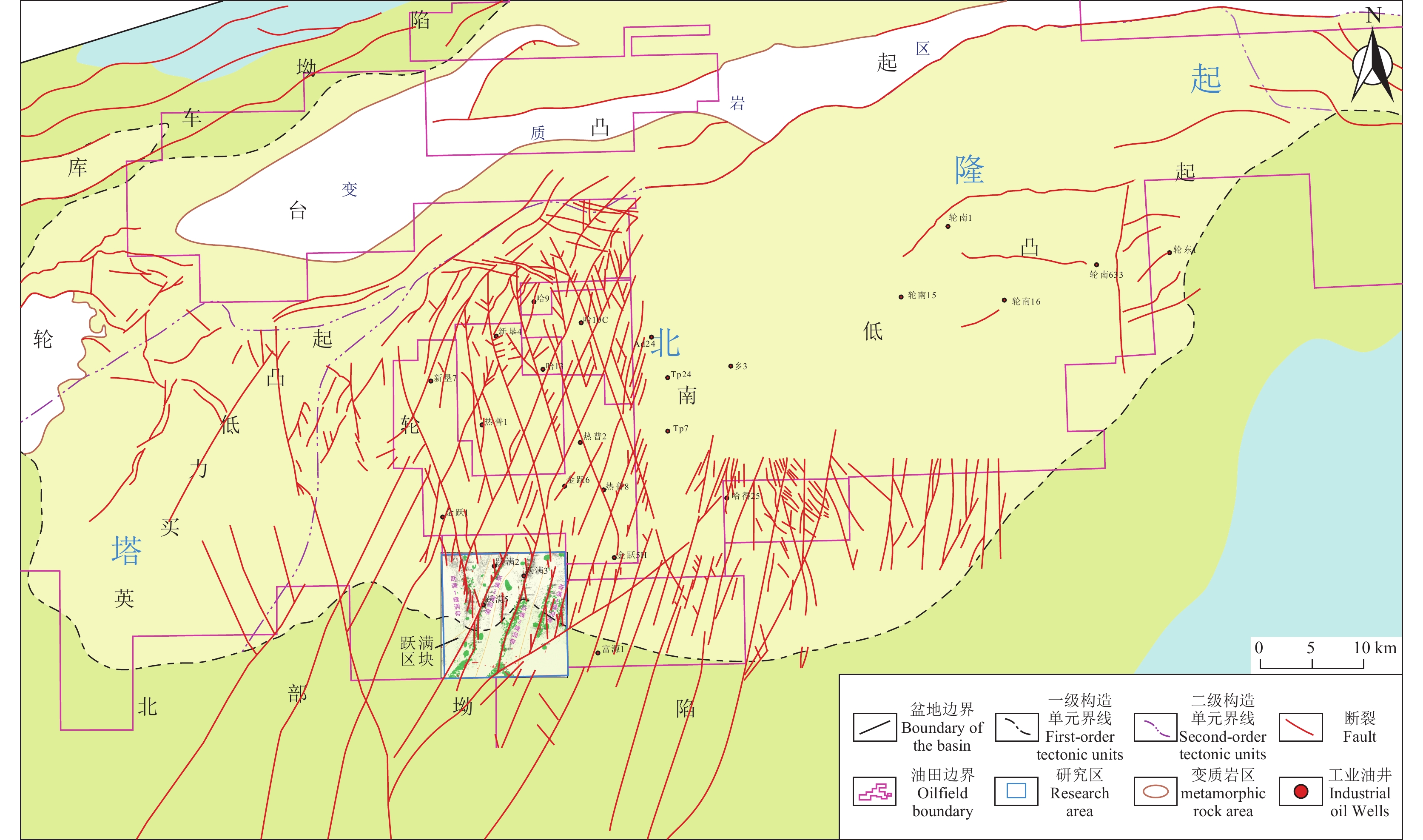
 下载:
下载:
